One of 2020’s Thursday Night in My Studio Live! presentations featured my quilt “Kaloli Moondance.” This quilt of a marabou stork was made entirely of scraps, and that was the theme of the night, since we are all making do with what we had on hand in those early pandemic times.
I started the presentation with a 15-minute slide show, continued with a 10-minute improvisation using scraps to begin creating a fabric collage fish, then finished with a question and answer period.
I admit I quite enjoyed the 10-minute fish improve—I’d never tried timing myself like that before—and speculated to the online audience that maybe I’d get back to it the next morning—which I did. I kept using my little hedgehog timer at 15-minute intervals and set up my phone to record my progress. After five “hedgehogs” (about 1-1/2 hours since it was hard for me to stop when the timer went off) the first draft of the fish, all foundation fabric covered, was finished. Gluing, details, and background still to come, but good progress for less than a couple hours of playtime. Tom has turned those five videos from yesterday morning into one four-and-a-half minute time lapse video, below. Enjoy!
I have included the slideshow portion of Thursday Night’s presentation as an update to this Quilt Story of “Kaloli Moondance” (see video below). Enjoy. Take care, everyone.
Quilt Stories: Kaloli Moondance (Update with Slideshow)
Original Posts
I’ve included the final of four blog posts describing the creation of “Kaloli Moondance” in the text below. To read how it began and progressed click on the following links to the first three posts in the making of this quilt:
1. Post date July 30, 2016: In Progress: Marabou Stork for Special Exhibit at IQF
2. Post date August 20, 2016: In Progress: Marabou Stork 2
3. Post date September 10, 2016: In Progress: Marabou Stork 3
4. Post date October 22, 2016: In Progress: Introducing “Kaloli Moondance”
Whew!
After an intense few weeks with little sleep and a lot of leaning on my family, the quilt of Chloe the Marabou Stork is finally done. I won’t make you scroll to the end. Here she is.
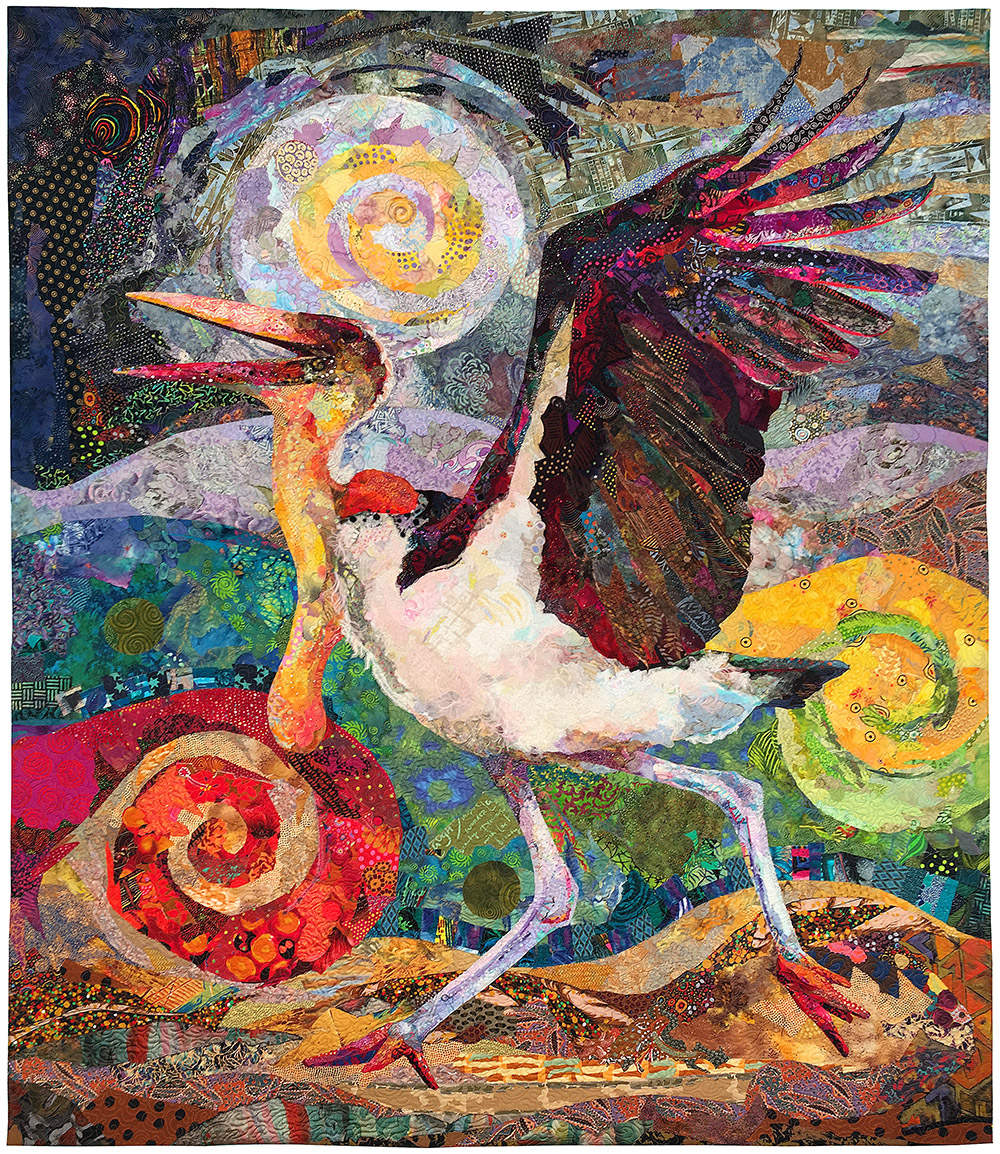
The title “Kaloli Moondance” was given to recognize the Ugandan name for the marabou stork Kaloli Bird and the beautiful harvest moon that shone down on those late nights as I was finishing this quilt.
I gave the making of “Kaloli Moondance” a similar time-lapse treatment as “Crocodylus Smylus.” See the video below for a two-minute version of the making of. The rest of this blog gives a more detailed look. Three previous blog posts cover the early stages of the construction. Here are links to Part I, Part II, and Part III.
In the end, this quilt took everything I had, even my blood when I pricked my finger with a needle. I worked right up to the deadline. On the last day, I finished the binding and sleeve, had it appraised (Thanks, Bonnie Dwyer!), photographed (Thanks, my husband Tom!), boxed and delivered to the FedEx drop off with 20 minutes to spare making “Kaloli Moondance” the 11th and final quilt to arrive in Houston for my “Specimens” special exhibit at the International Quilt Festival in early November.
To be fair to myself, some family issues did step in to take away some valuable time, though I do tend to work right up to deadlines anyway. It seems to be part of my creative process. However, the all-nighters are getting a little harder than they used to be!
Speaking of Process”¦
When you last saw Chloe, this is what she looked like:
I’d run out of space on my drawing board. It was time to shift her to a larger pinning board. In the photo above I’ve leaned a 6 x 8-foot piece of one-inch styrofoam insulation up against “Crocodylus Smylus,” which was fully occupying my studio pinning wall.
Once Chloe was transferred over, I had enough surface area to finish sketching out her legs and the upper tips of her wing.
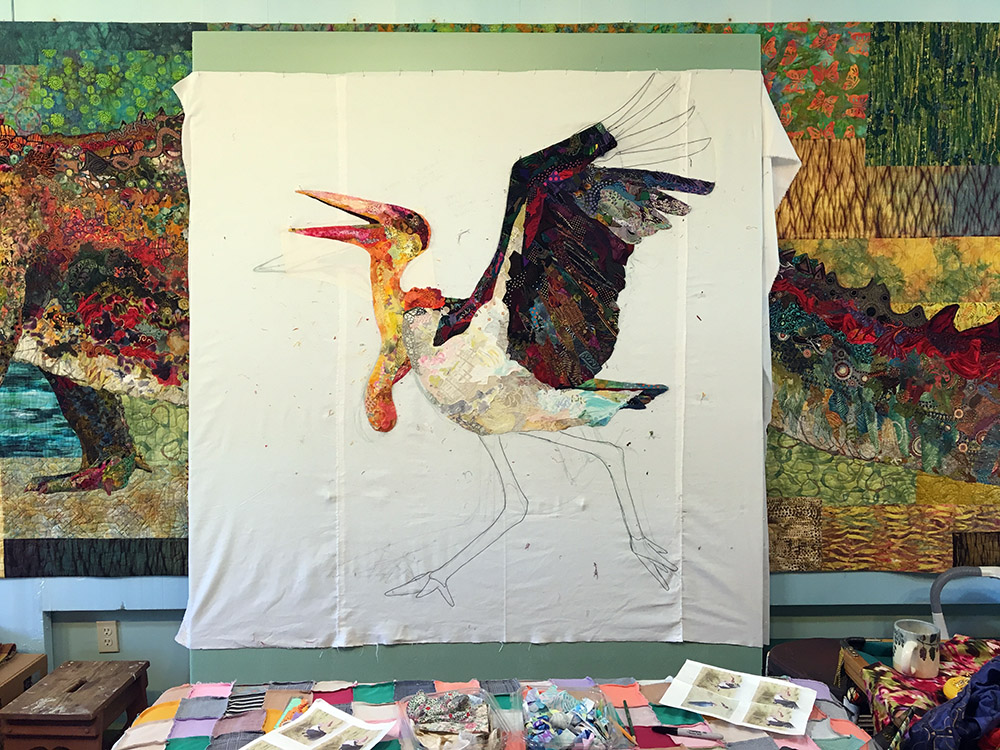
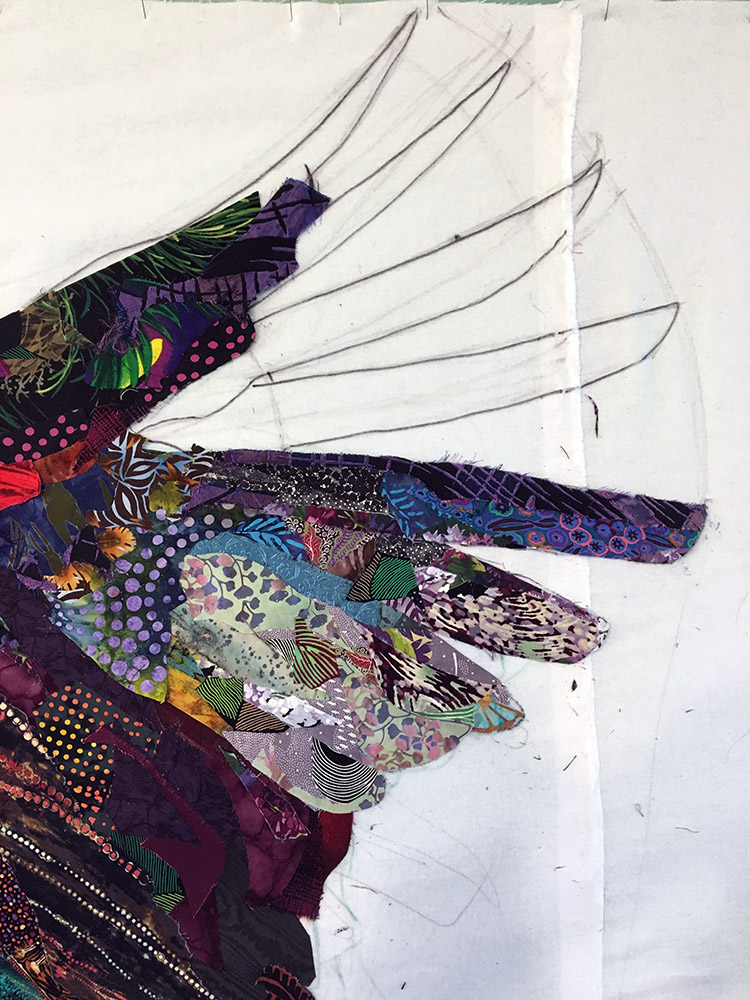
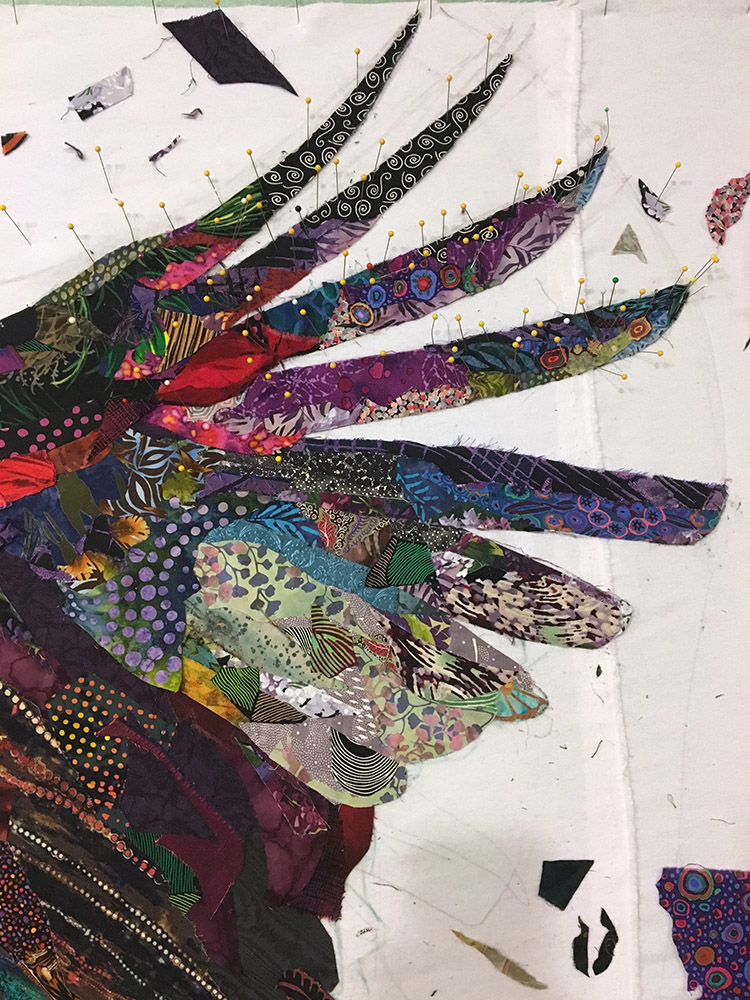
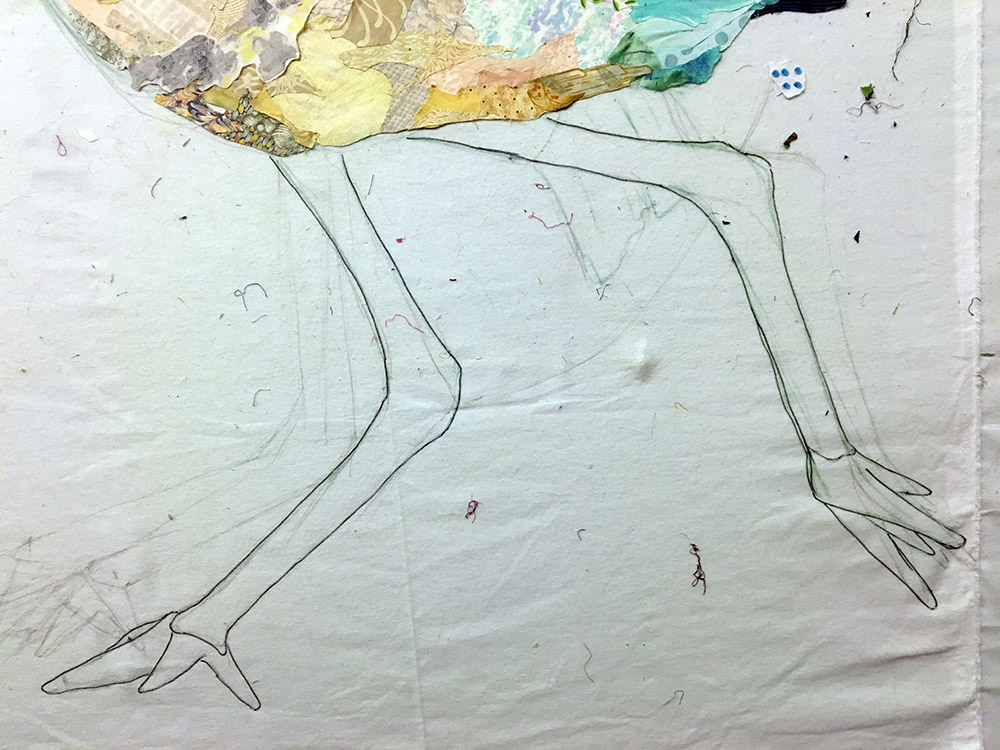
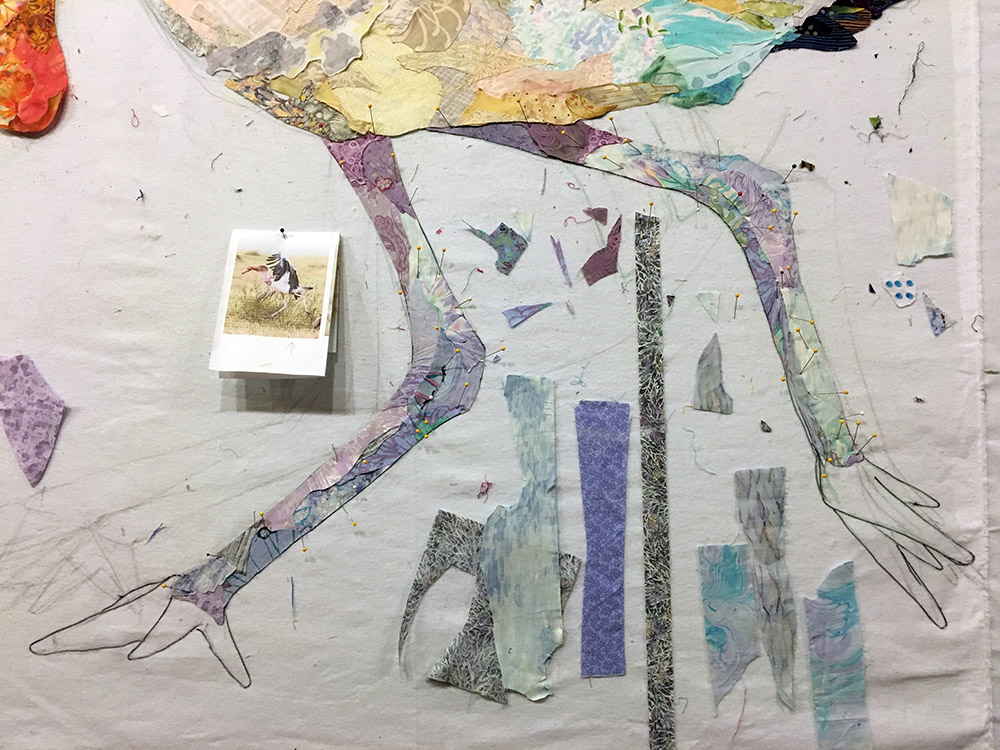
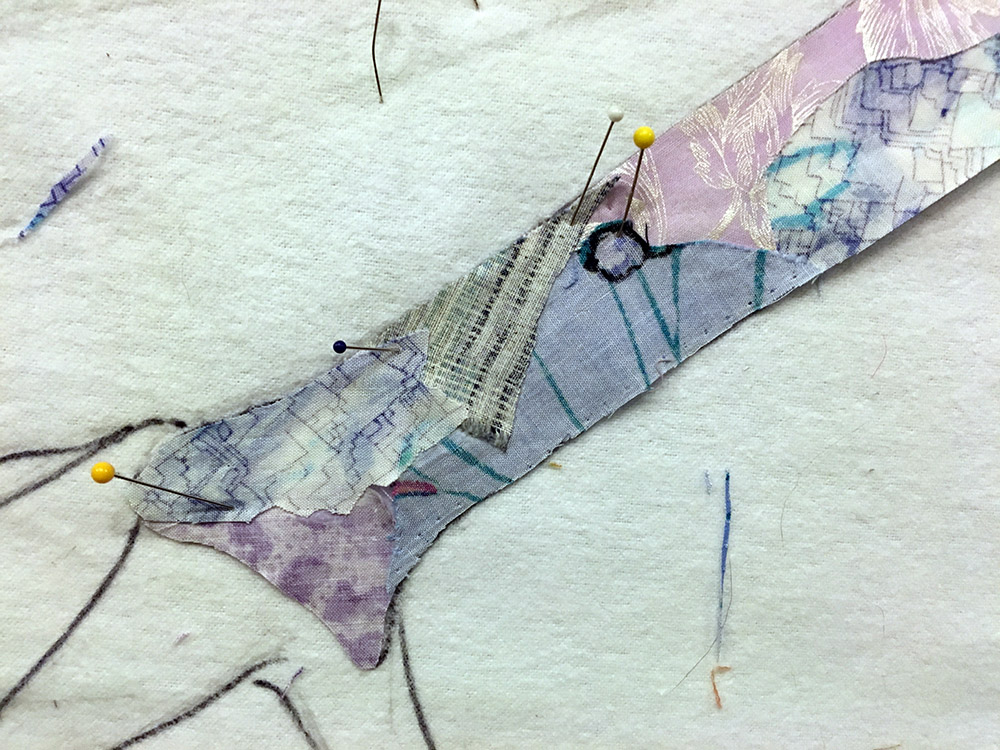
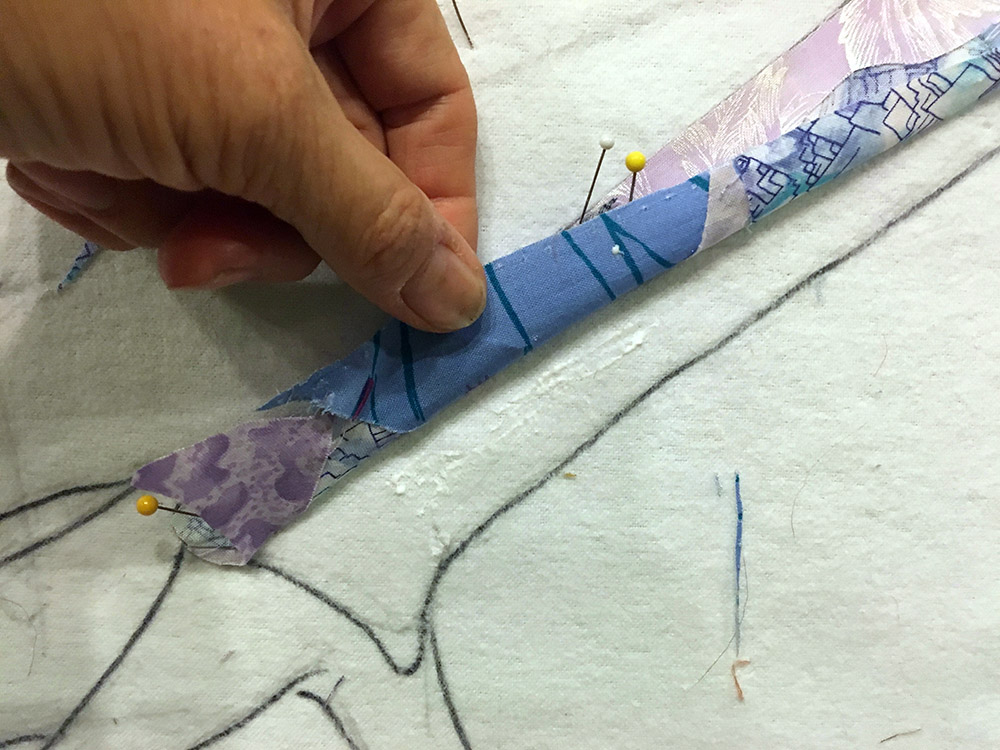
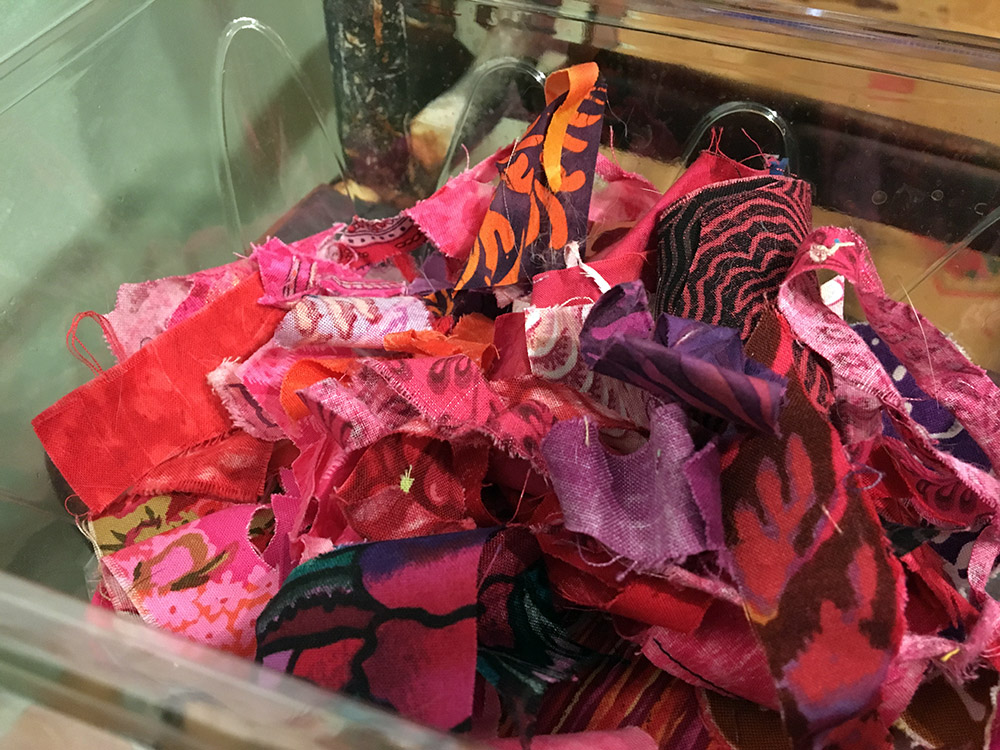
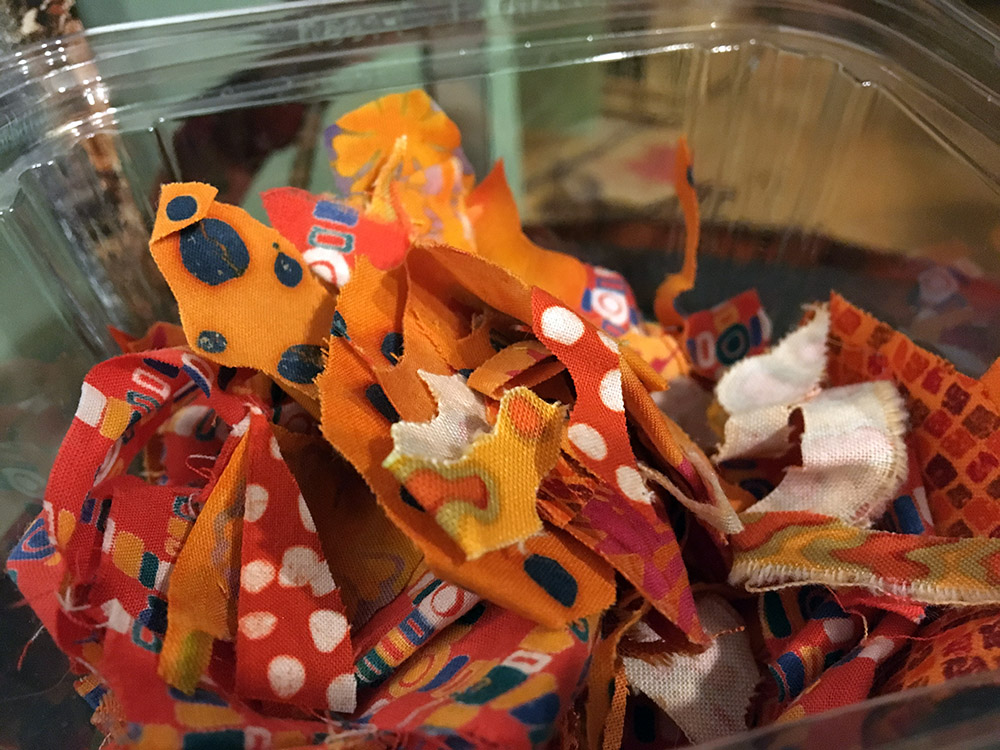
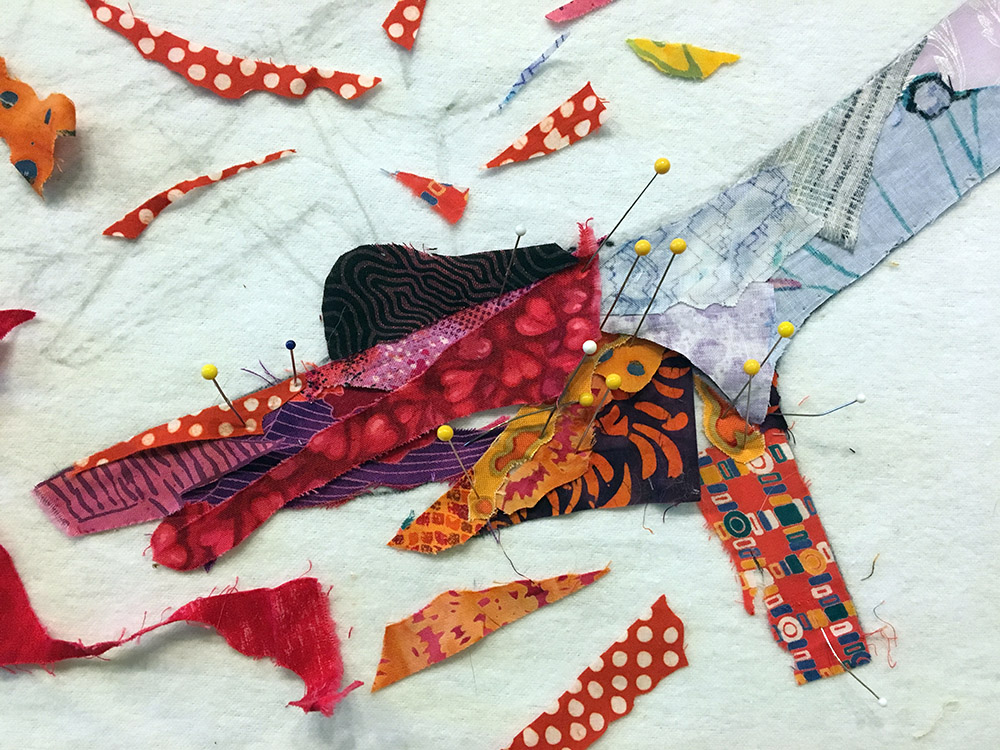
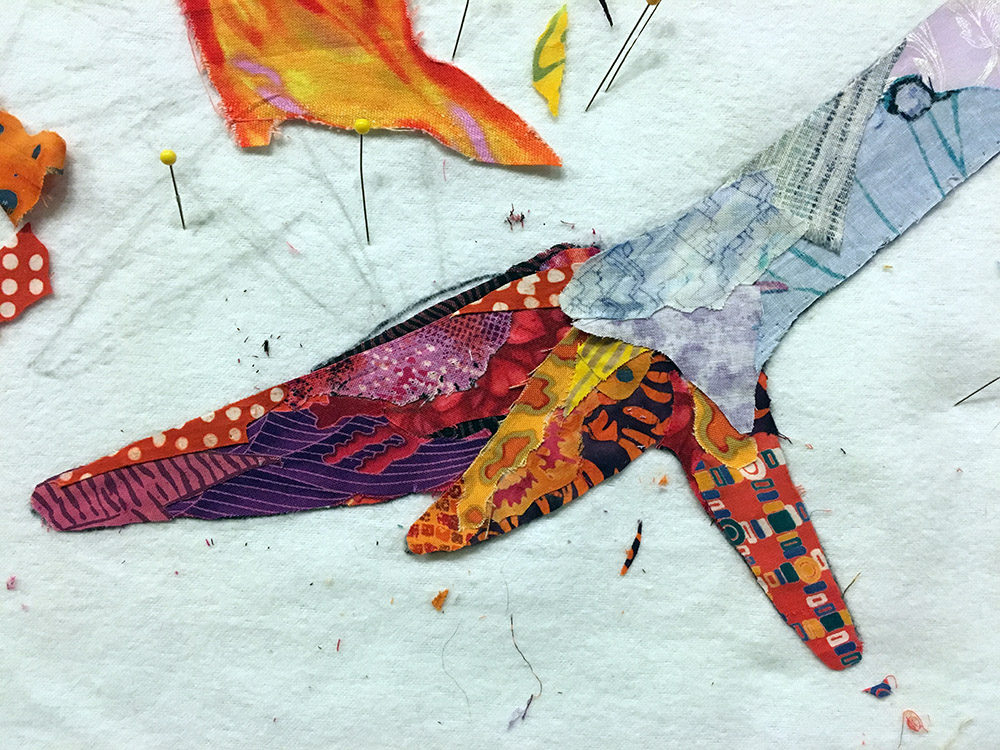
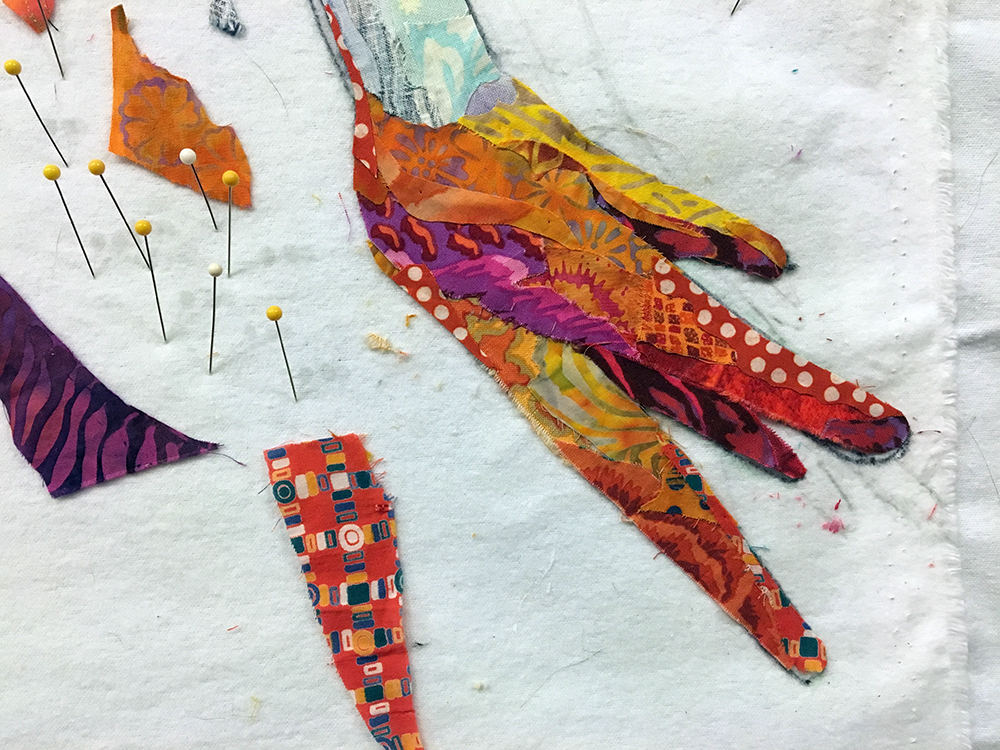
During this time, I had a visit from Joel Davidson, husband of one of my students Marilyn Davidson, who also stopped in to see Chloe. Joel is a talented photographer, who had generously allowed me to use his photographs for the design of my stork.
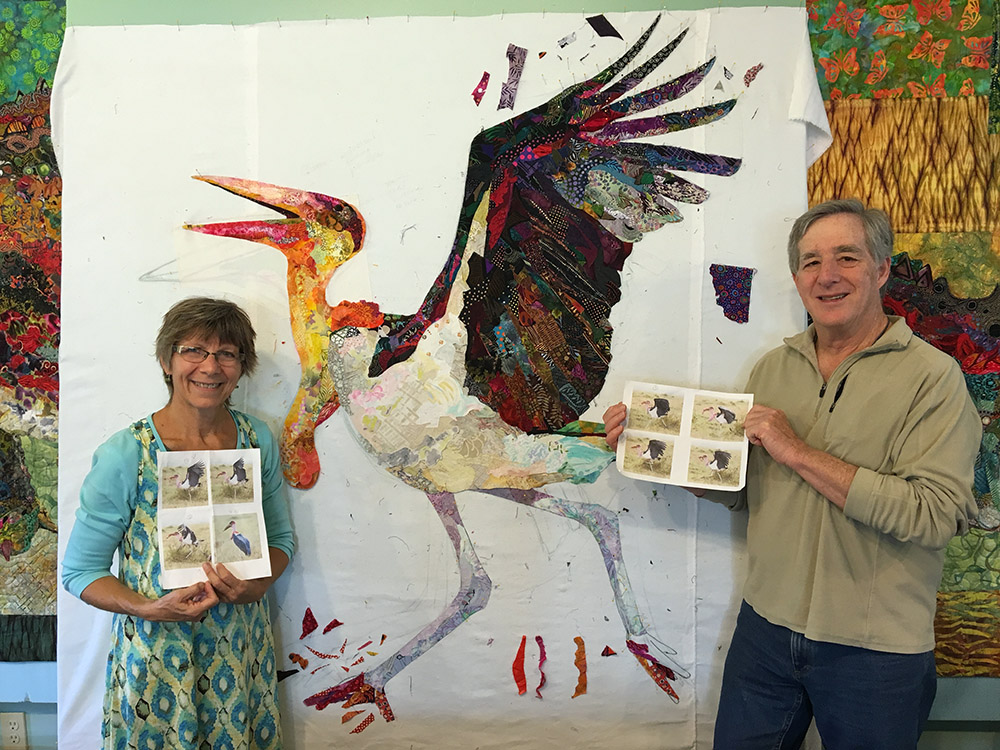
Background
At some point I’ll have to devote an entire post to backgrounds. In this case, I had decided to continue using only scraps for the background as I did with the stork. But I needed to figure out what scene I was going to place Chloe in. Since marabou storks are native to Africa, it made sense to do a savannah of sorts.
As timing would have it, I was deliberating this background as September’s Full Harvest Moon approached. I was working late and early hours in my studio, walking back and forth to our house in the moonlight. The thought of placing a full moon behind Chloe started to form”¦ then adding the flowing landscape”¦ then spirals to indicate movement of her “dance”.
The challenge of any background is to highlight the main image. This means avoiding colors and shades of color that are of the same value as the image itself. Now, Chloe has both very dark (wings) and very light (belly and legs) parts of her, posing potential problems with a cohesive background.
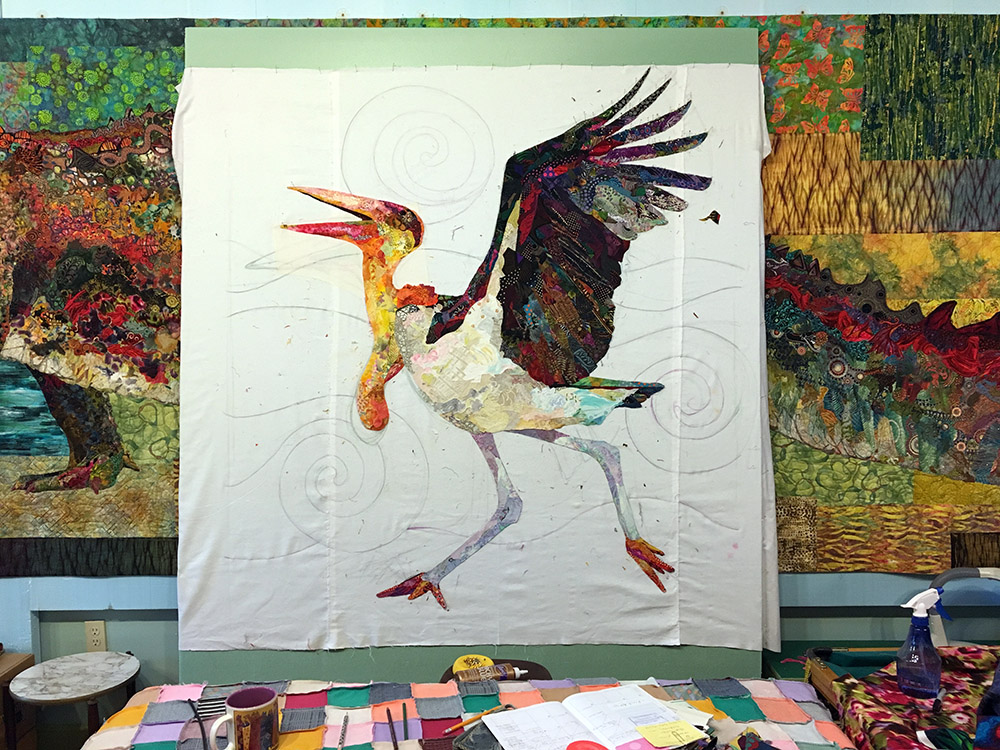
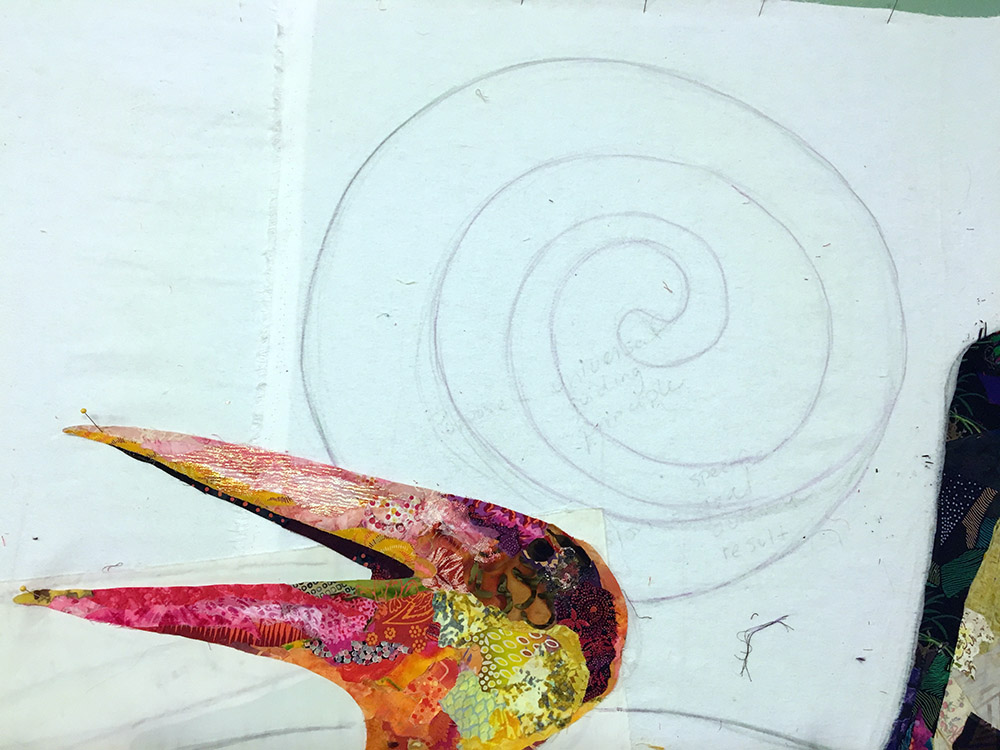
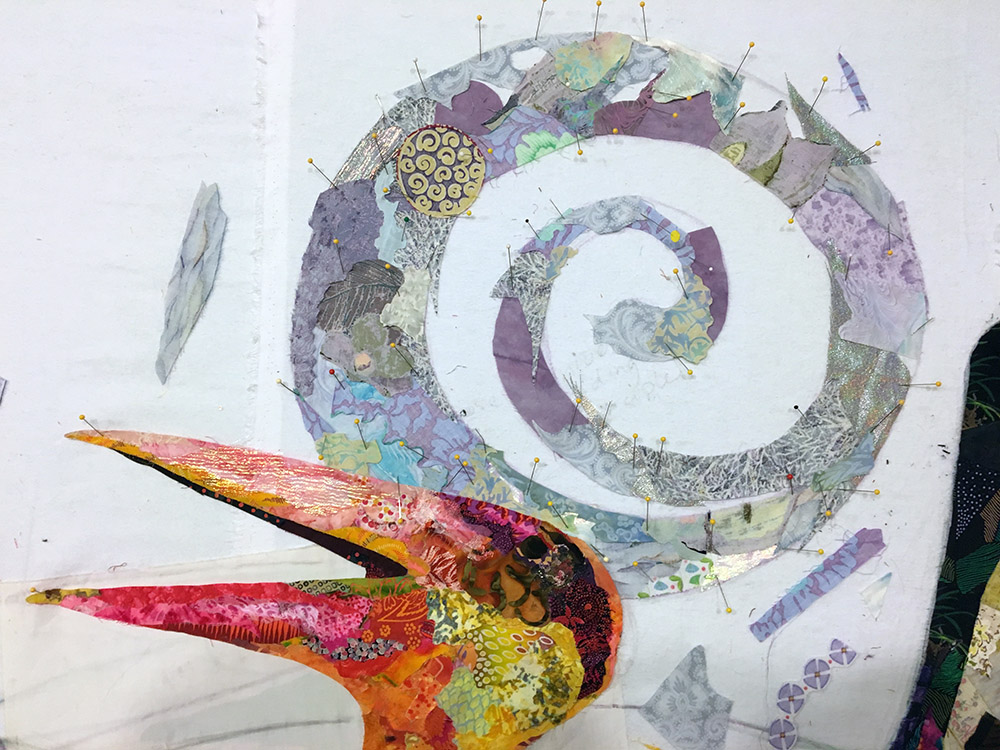
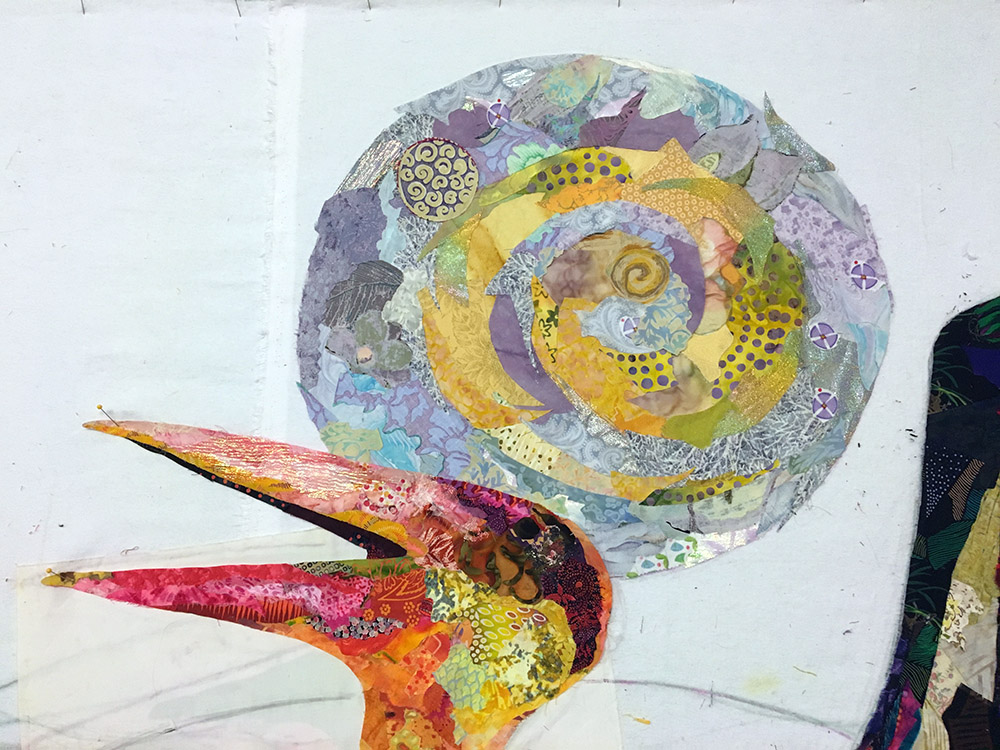
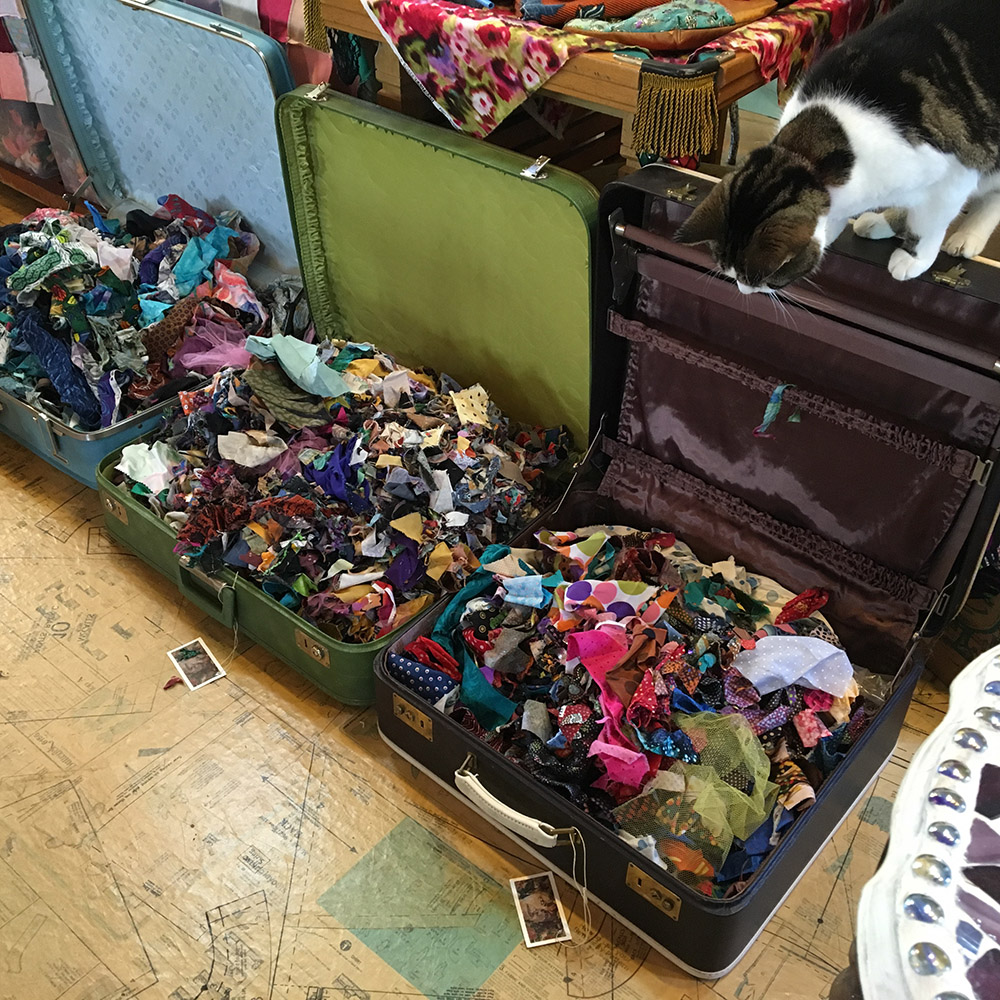
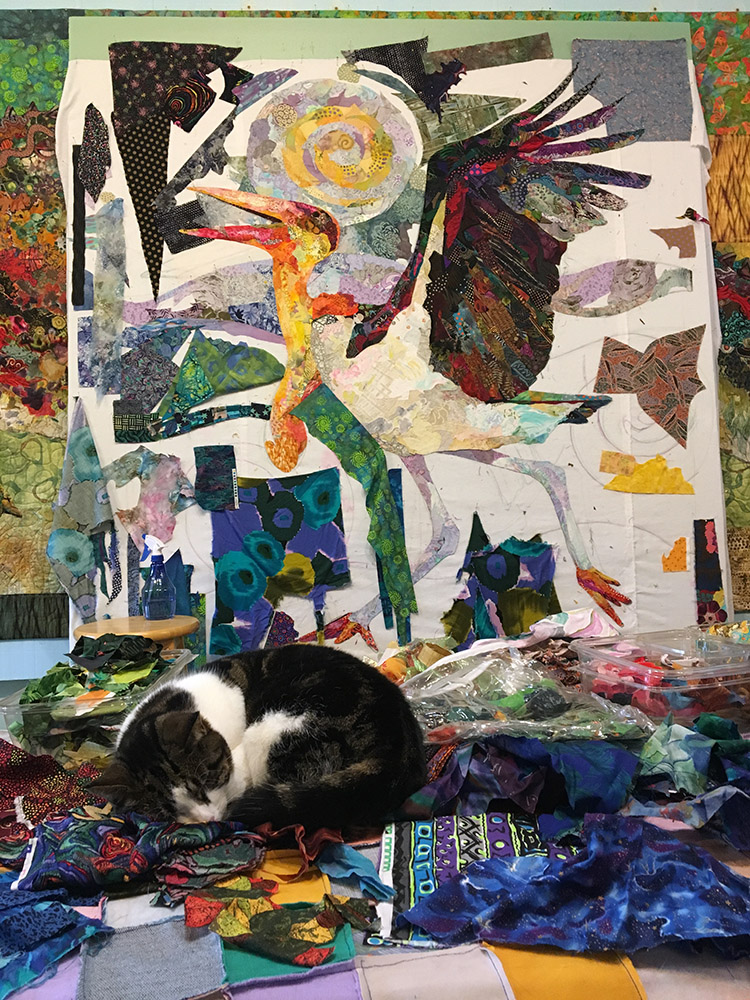
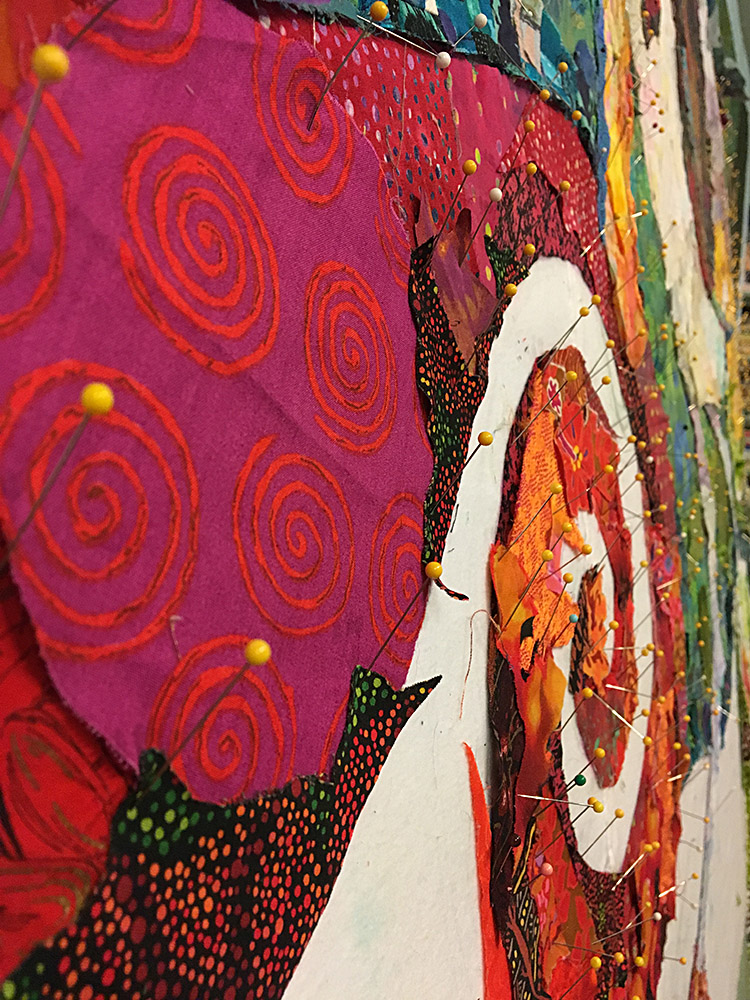
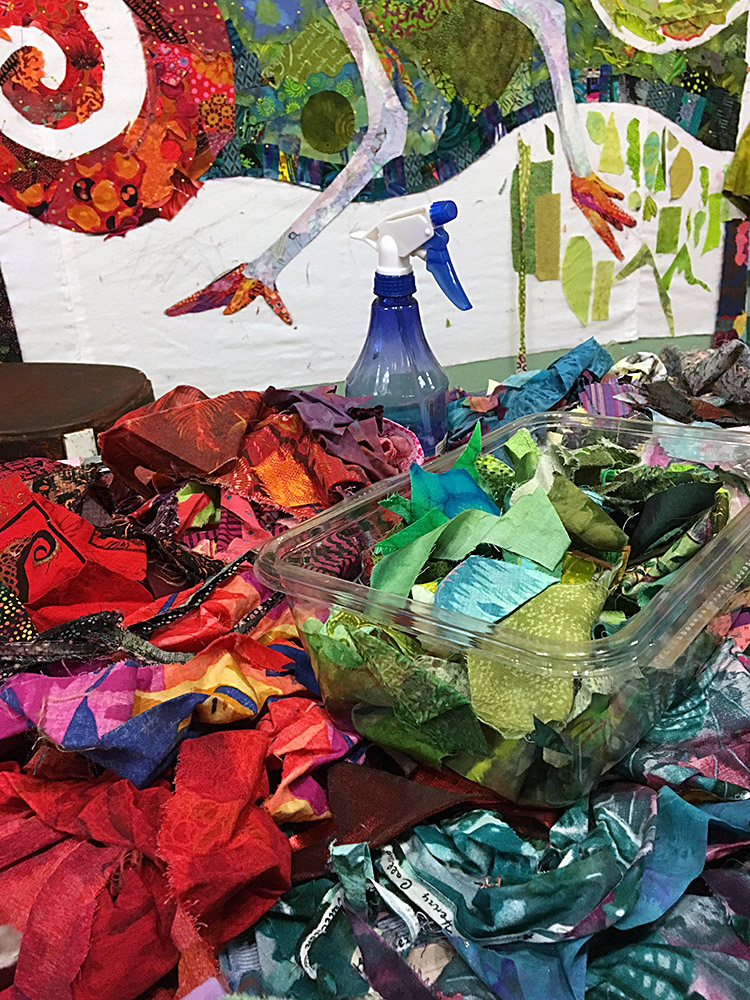
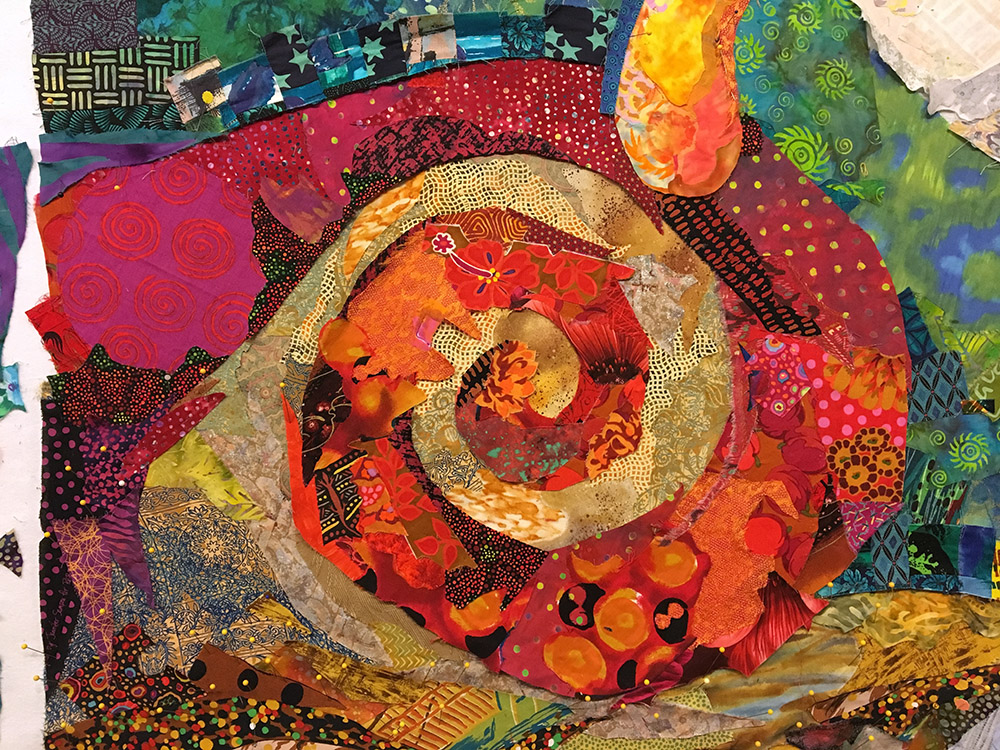
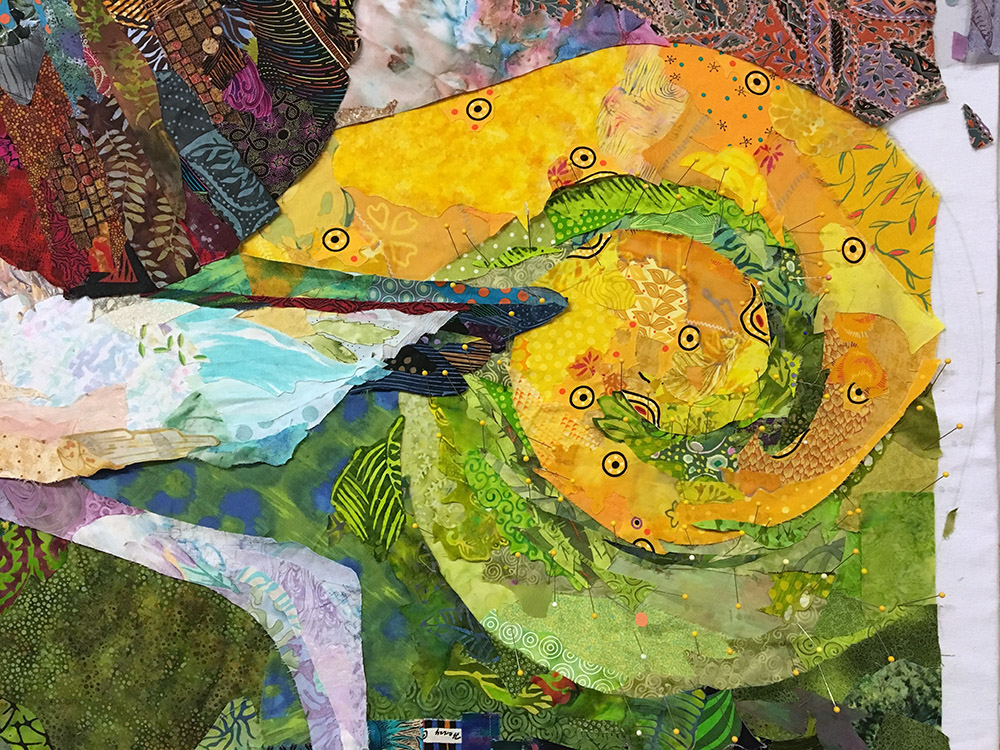
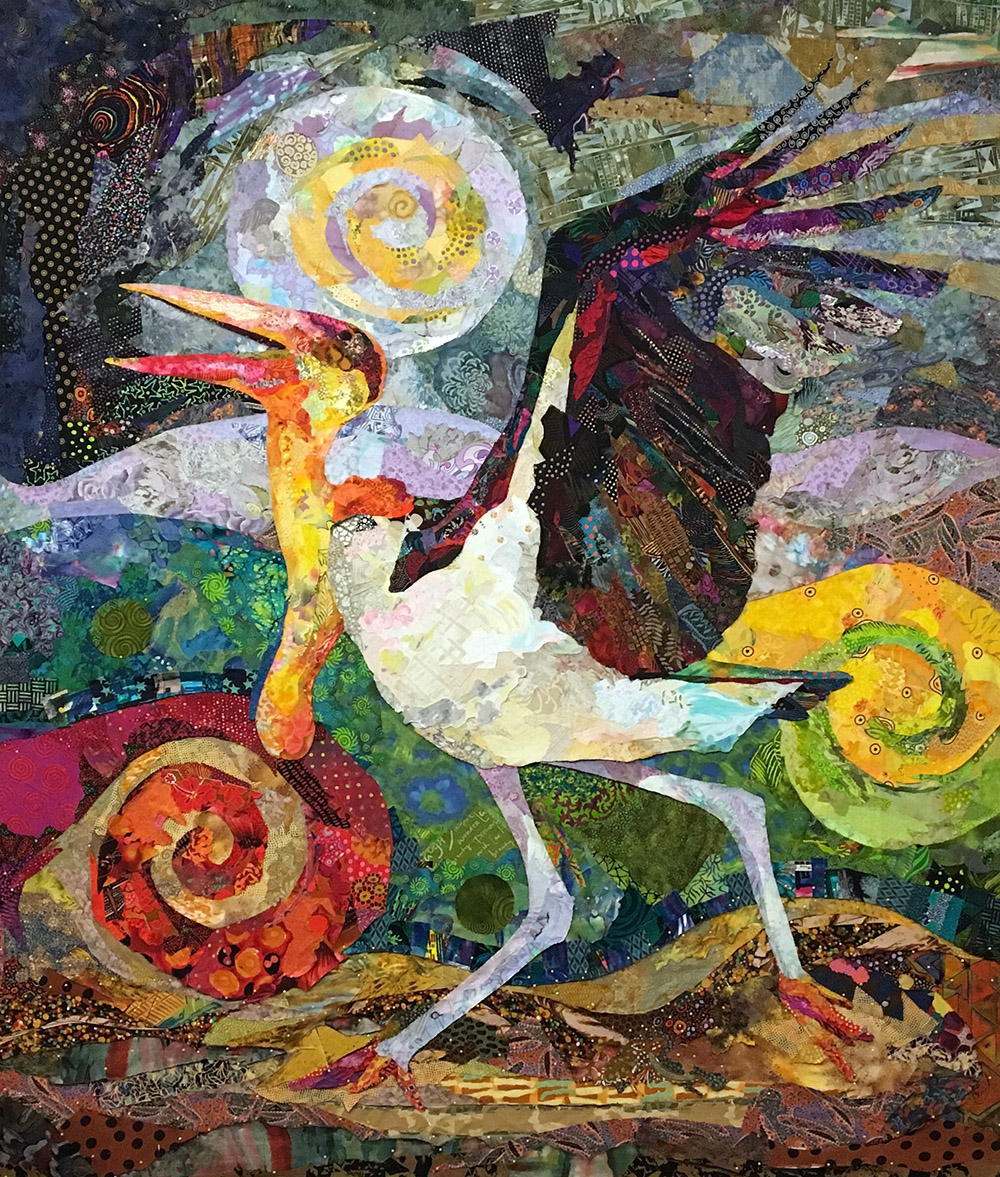
Finetuning
When I reach this stage (third draft/”dental draft“/final draft) I often make a list of things that need attention.
There was something about her eye that was bothering me (and Tom). Finally, by comparing her to Joel’s photo, we figured out it had to do with her beak. The opening wasn’t deep enough, which made the eye seem like it was too close to the back of her head.
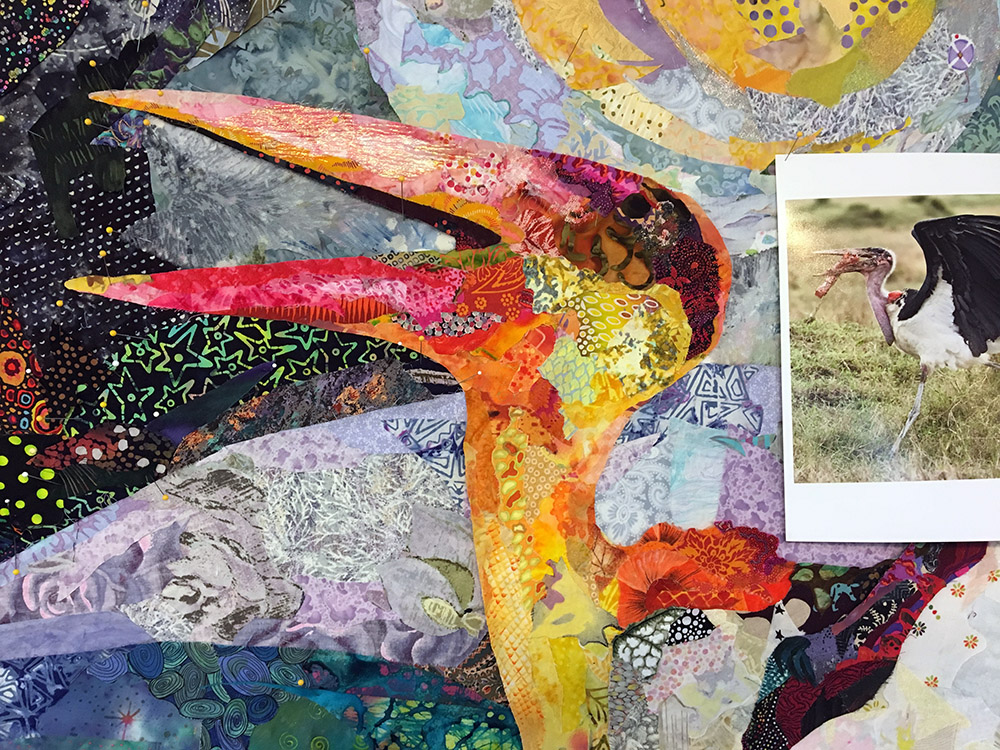
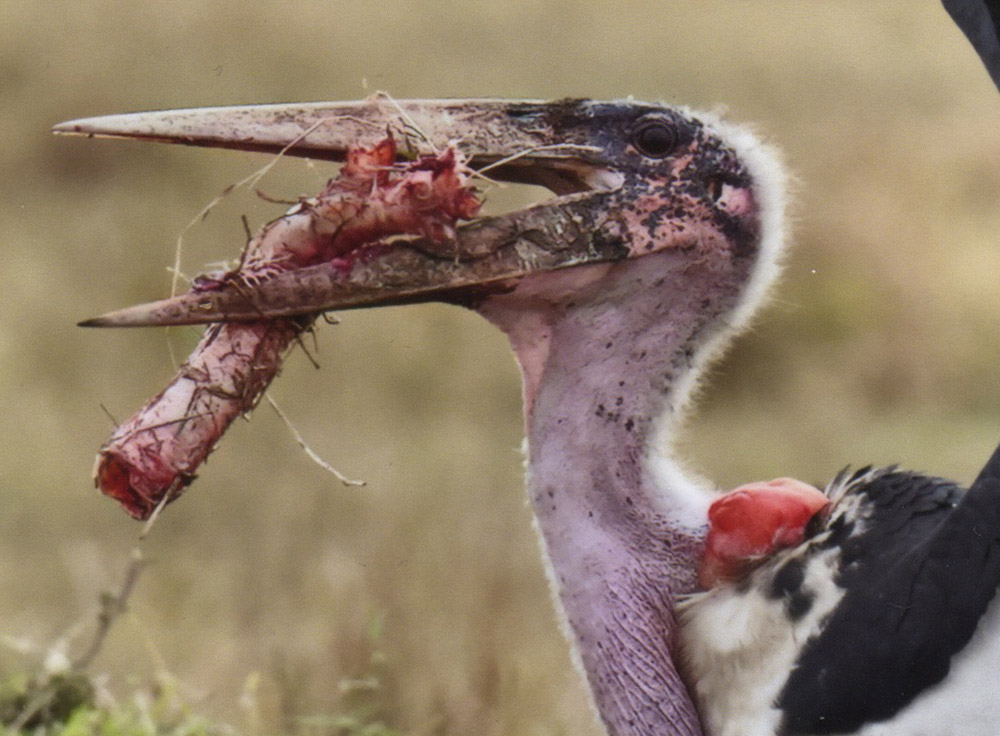
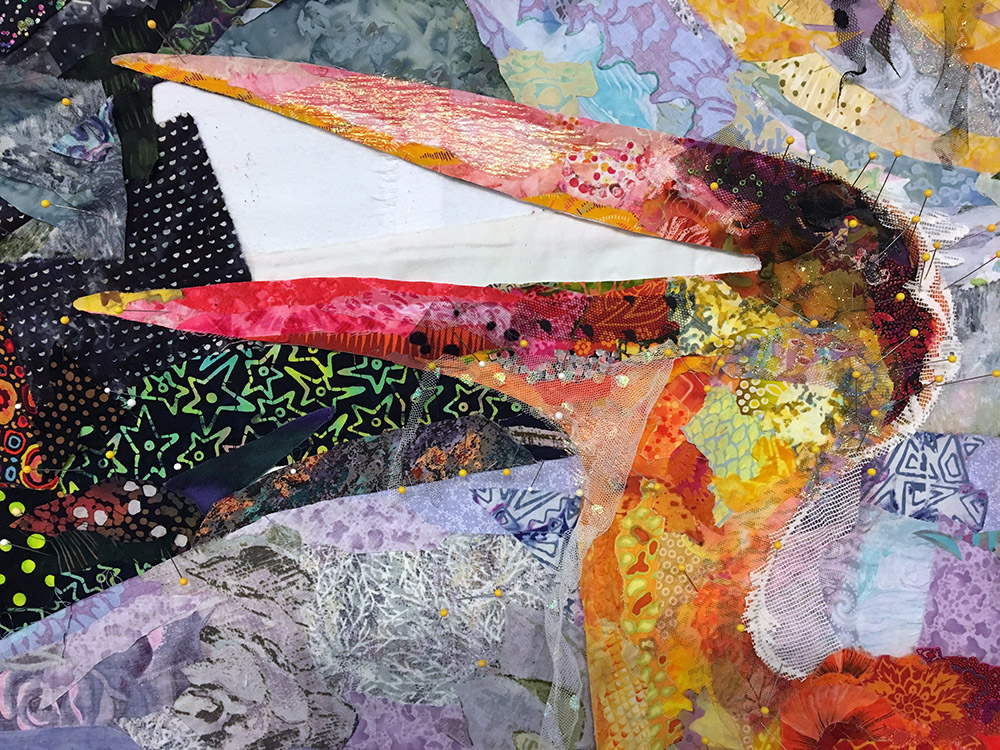
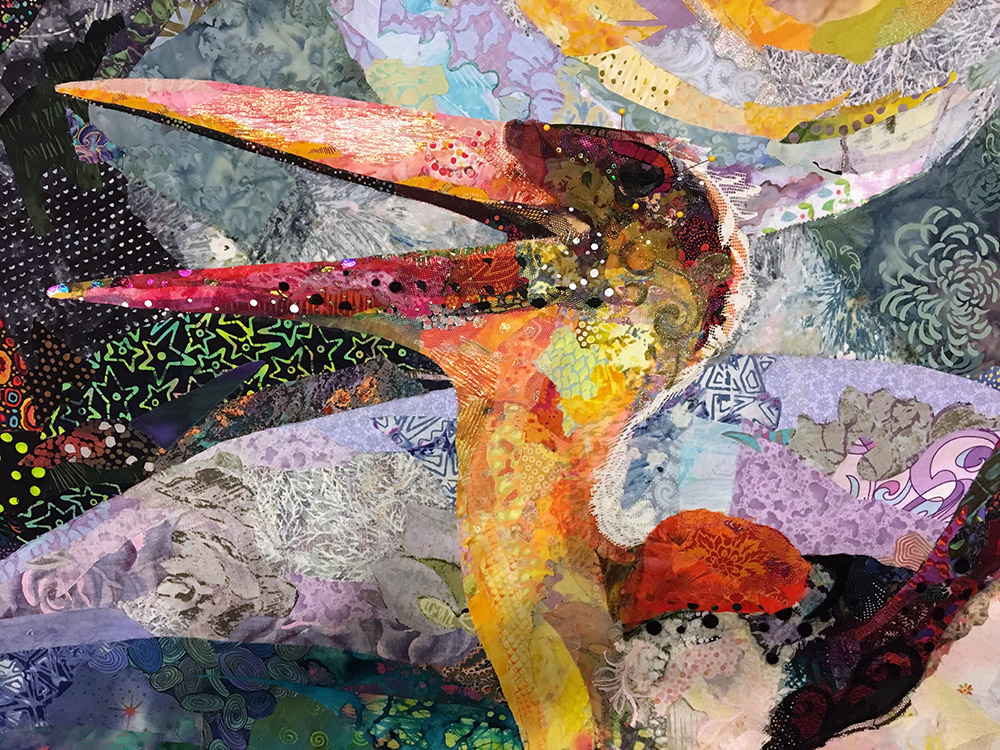
Another area I wanted to enhance was the chest and belly, adding form to the variety of white and pastel colors. Still scrounging through my scrap suitcases, I found several different kinds of lace and other sheers to layer over Chloe’s abdomen, adding some texture to her feathers.
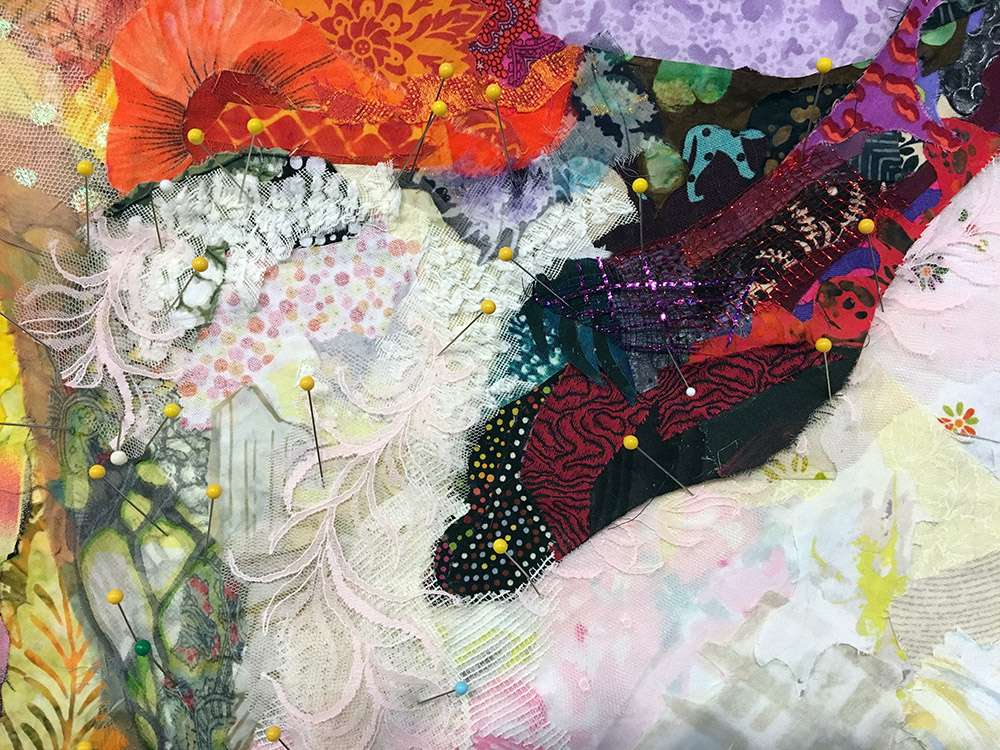
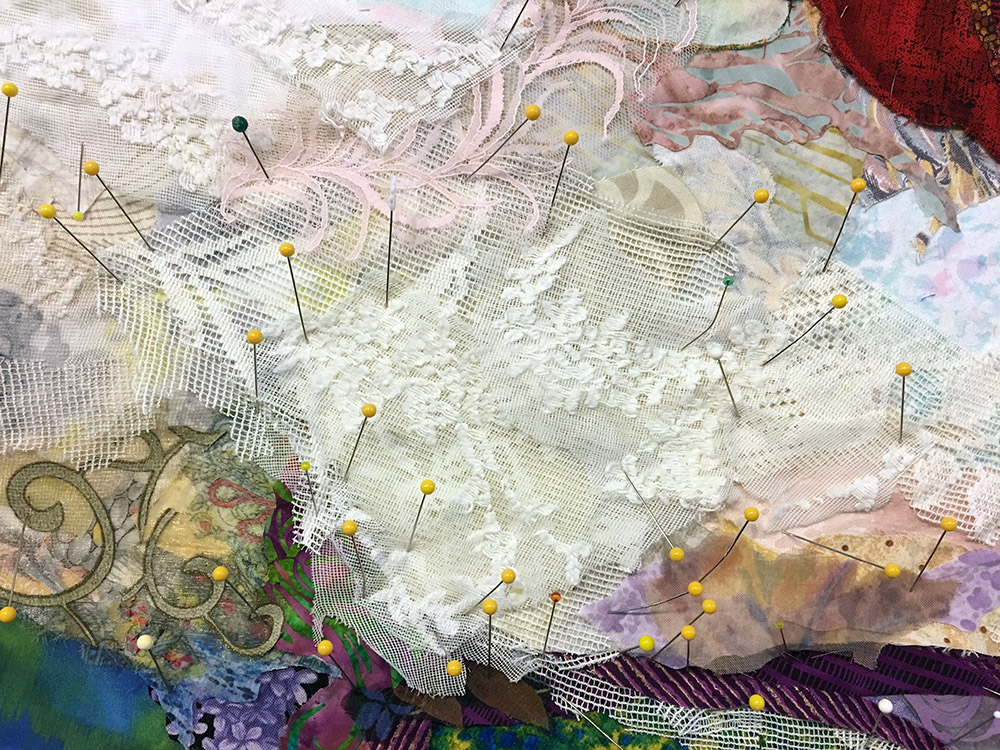
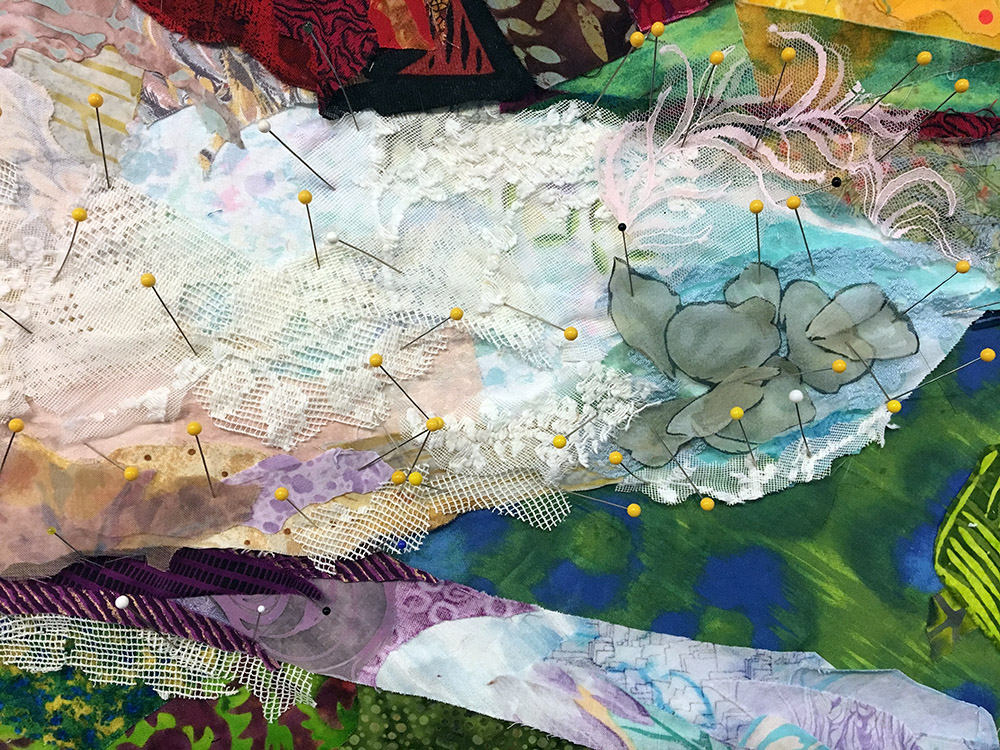
In the photo below notice how the edges of the upper wing feathers are not clearly delineated from the background.
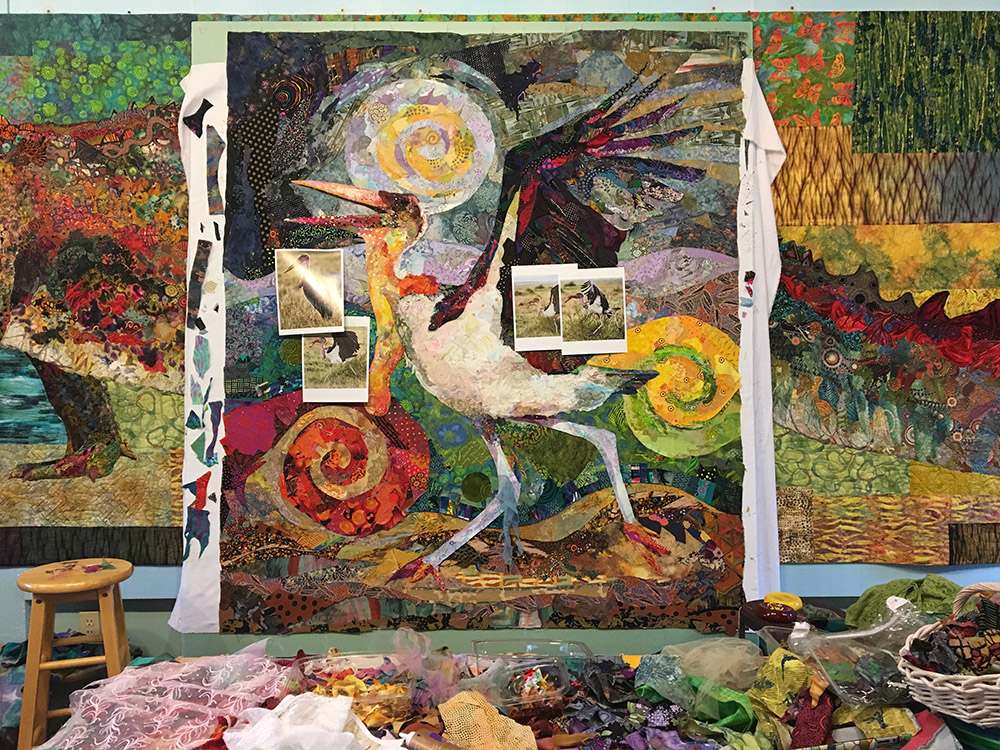
I chose to solve that by darkening and adding bright red highlights to the lower edges of the feathers. I don’t suppose it makes literal sense (where does the red light come from?) but it does help keep the wing tips from blending into the background.
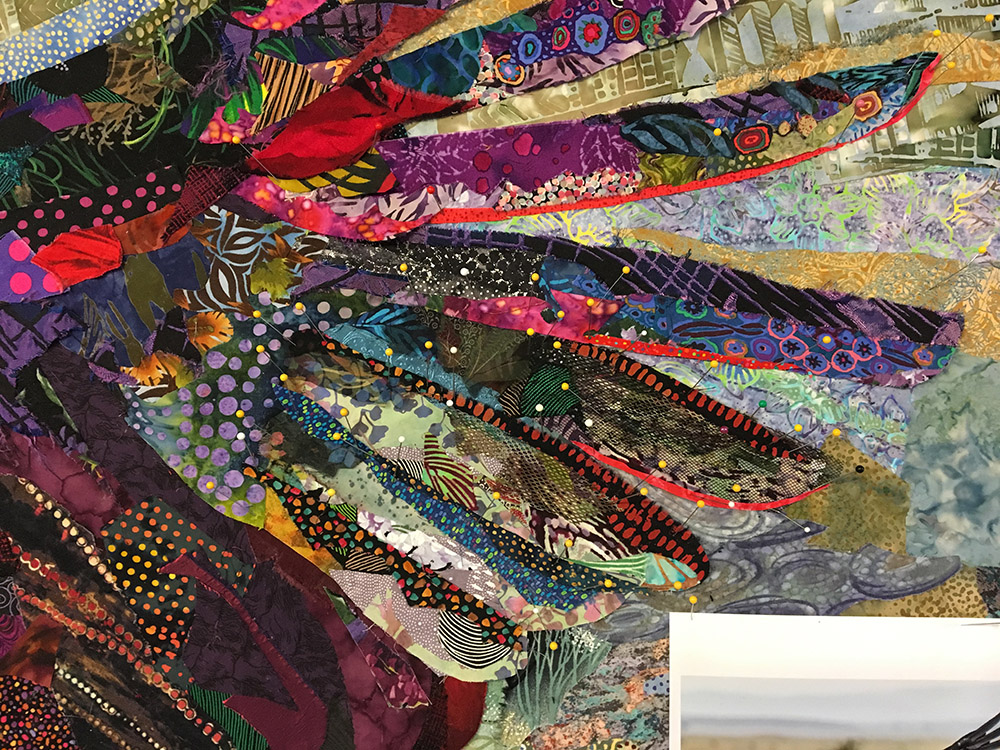
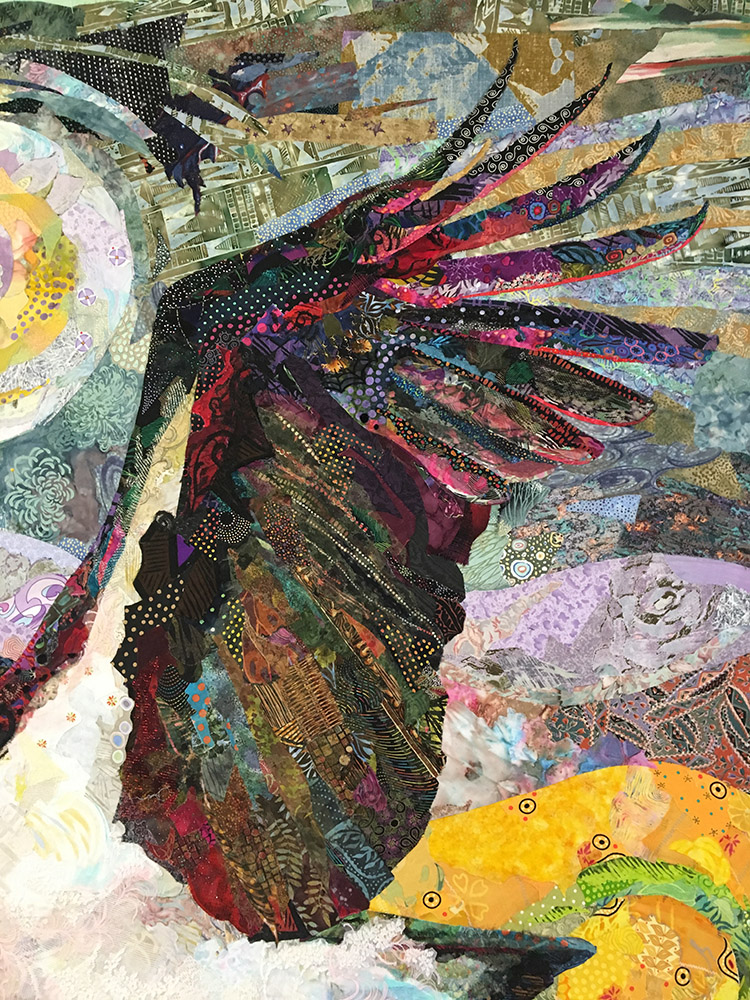
Finishing
Once I’d gone over the image with a fine-toothed comb, I started the finishing process. First I laid the glued image on the (vacuumed) floor of my studio and layered it with thin cotton batting and backing. I used safety pins to baste the layers together for quilting.
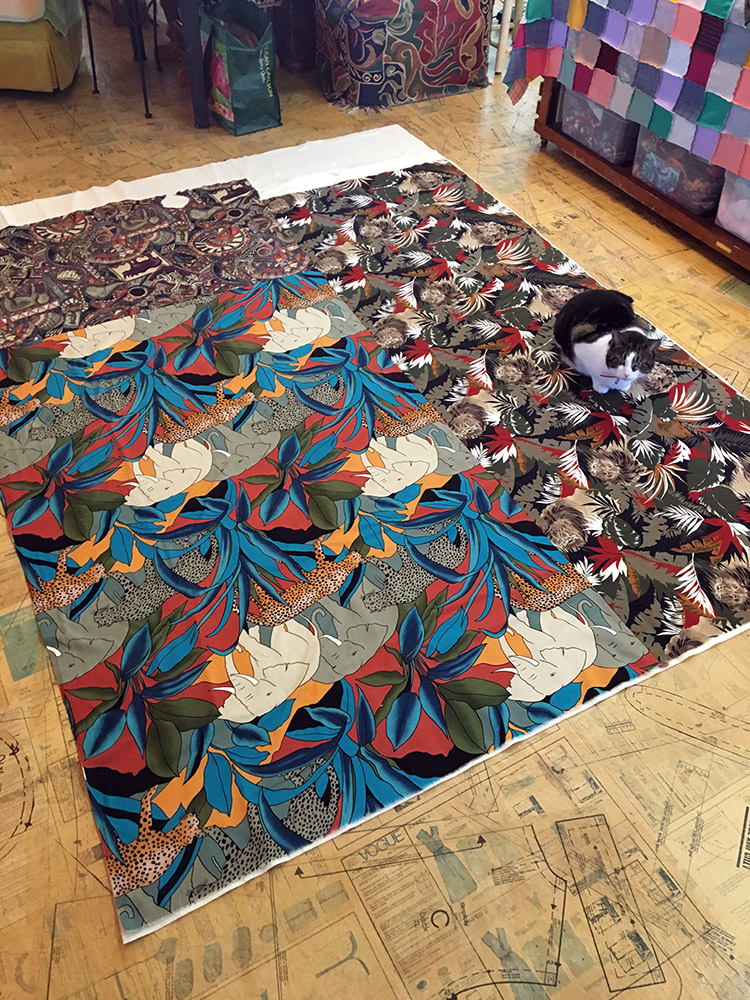
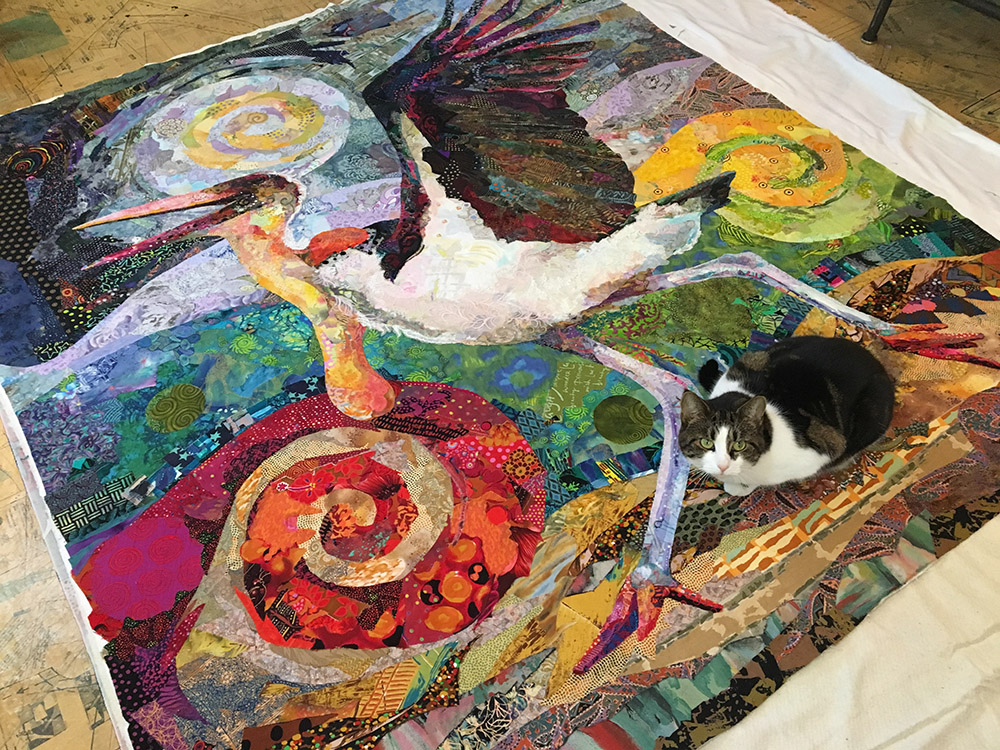
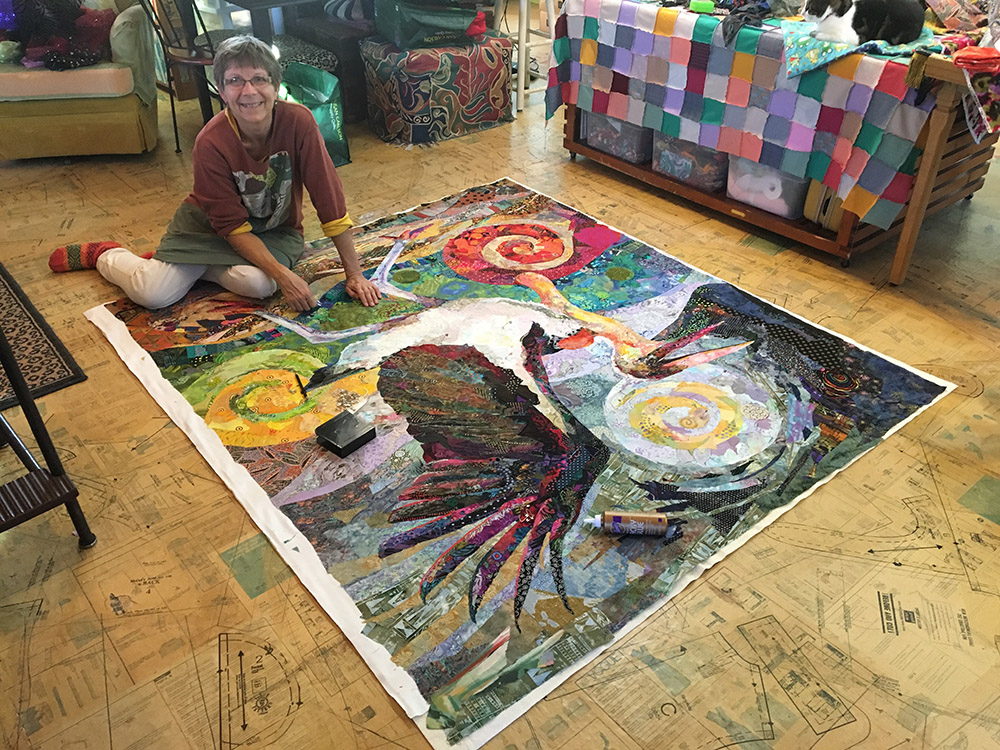
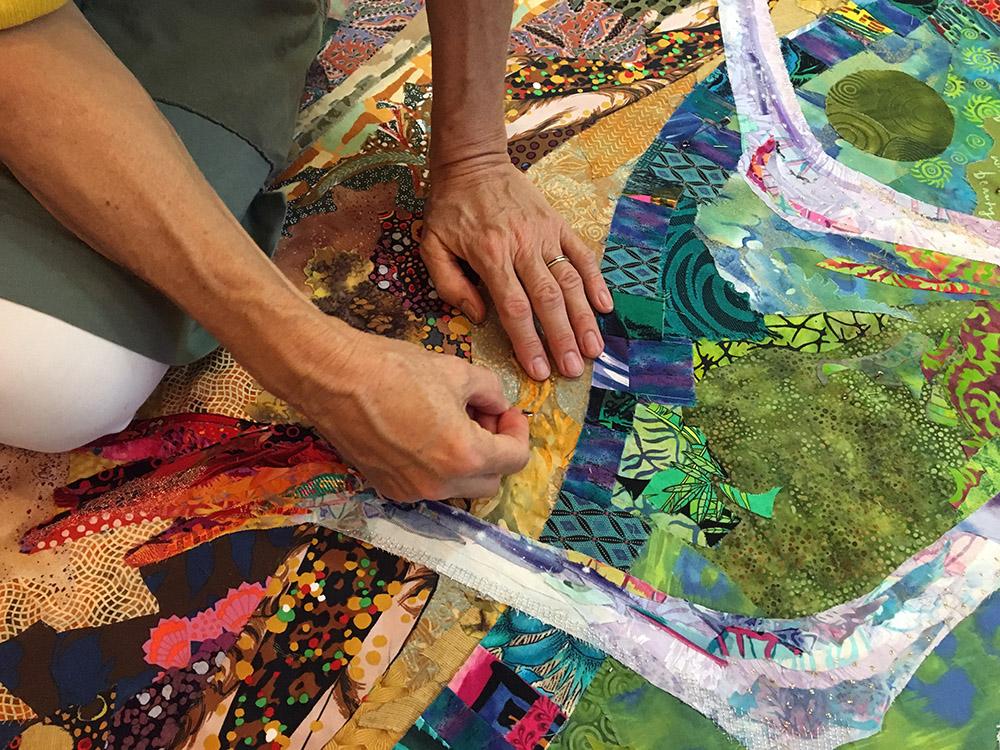
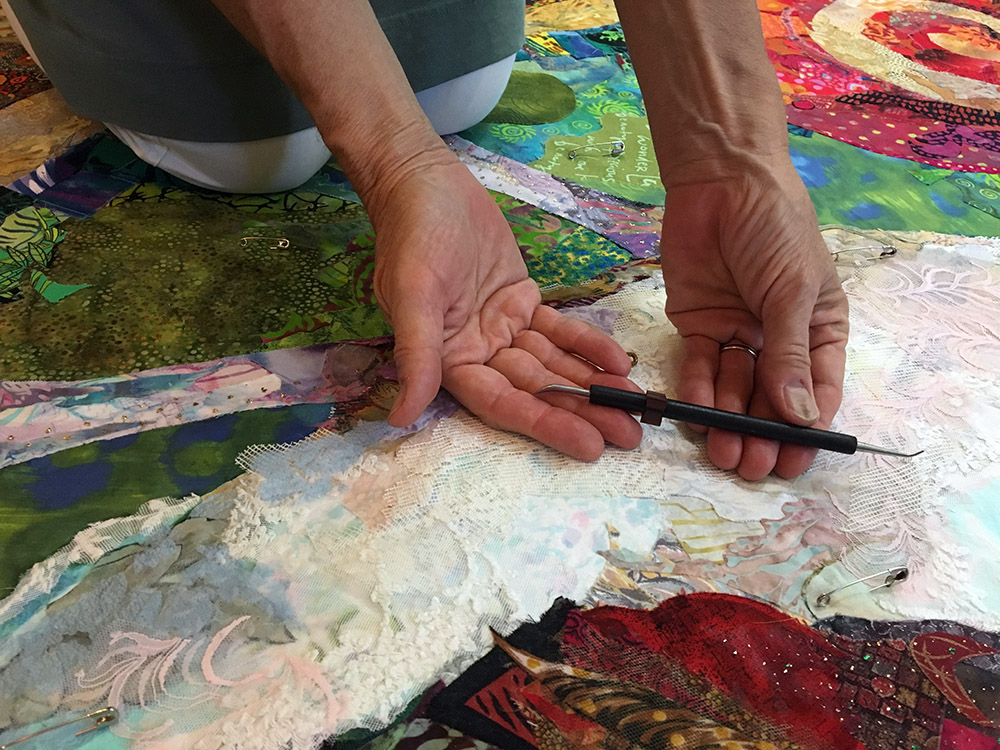
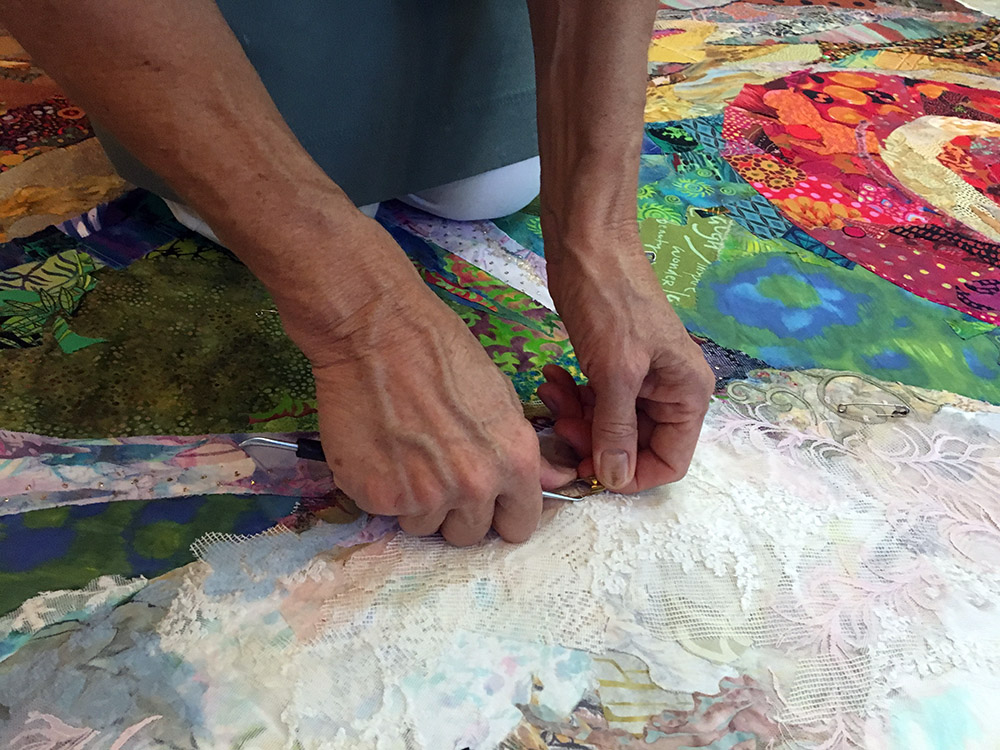
I quilted the piece using my good old reliable home model 1530 Bernina. But despite being adept at the quilting process, it always takes longer than I think it will.
Once it was quilted, I squared up the piece laying it on the floor, trimming the edges with a rotary cutter, and deciding to use a faced binding. I attached a binding strip to the front of the quilt, top stitched, then turned it to the back, pinned and hand-stitched it in place. In this way the top image goes all the way to the edge.
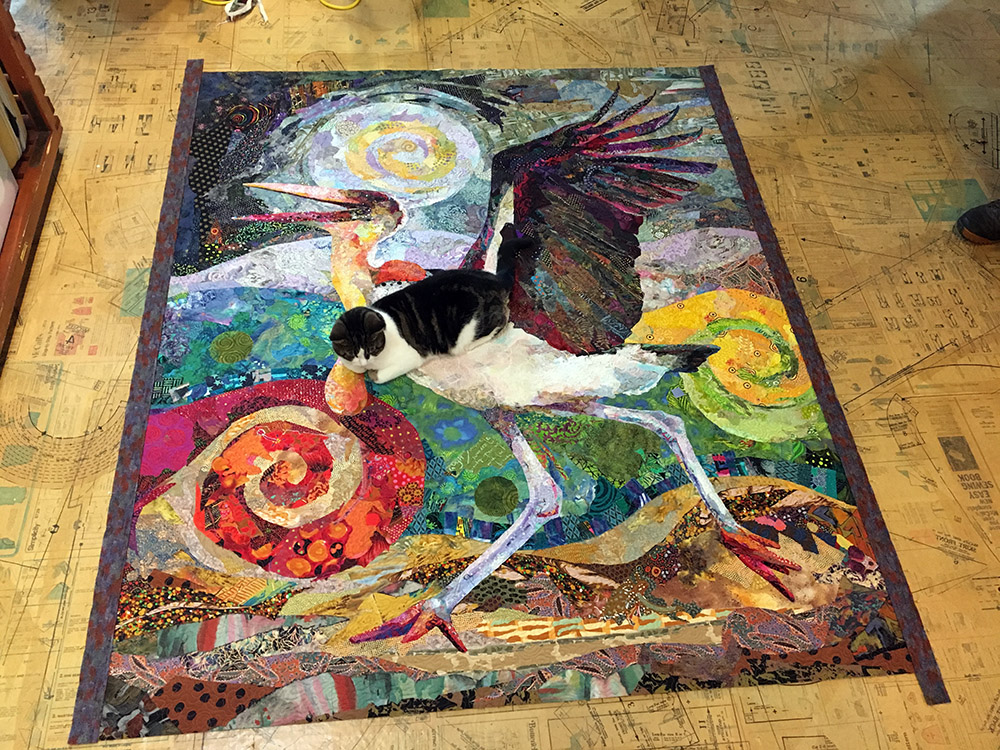
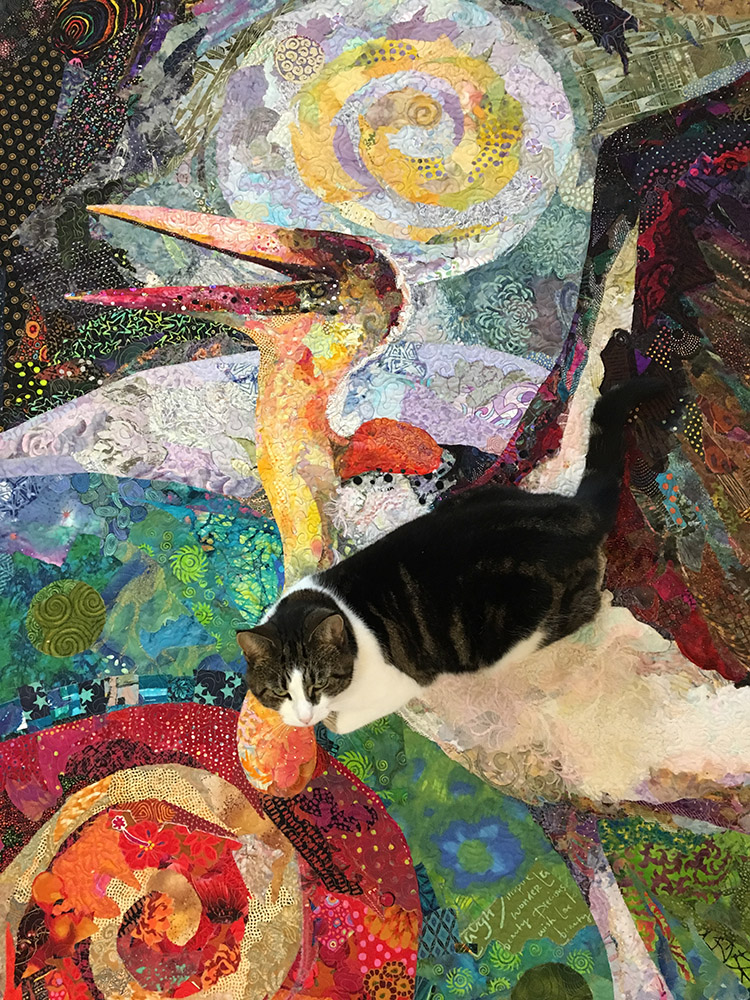
Finish
And that was that. No time for long goodbyes. Off she flew to Houston. And I had only a couple days to rest before hosting the second of my October’s Maine quilting retreats, this one the first held in our state’s largest city of Portland.
When I have time to further reflect on the making of “Kaloli Moondance,” I’m sure that all the stress and lost sleep will begin to fade in my memory. Rather like the labor of childbirth, if we didn’t forget the pain we’d never do it again.
The process of creating isn’t always so laborious, but it is work. Enjoyable work, but a labor nonetheless. What keeps me going is a love of this work. It would have to, wouldn’t it? Otherwise I would never devote hundreds of hours to a single piece.
So, what’s next? What image will capture my attention? Will I do a vulture, the scrappy scavenger I had originally in mind? I have no idea. Let me catch up on some sleep and I’ll let you know.
To see “Kaloli Moondance” and the other quilts in my Specimens exhibit at the 2016 International Quilt Show in Houston, Texas, check out this link from November 5, 2016: Specimens at the International Quilt Festival.
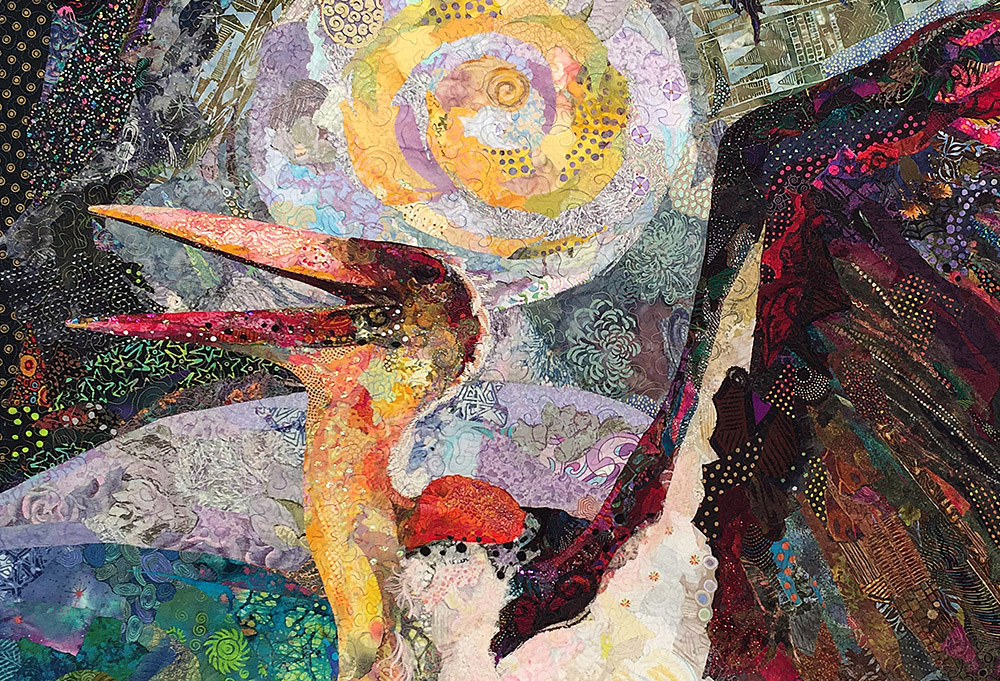
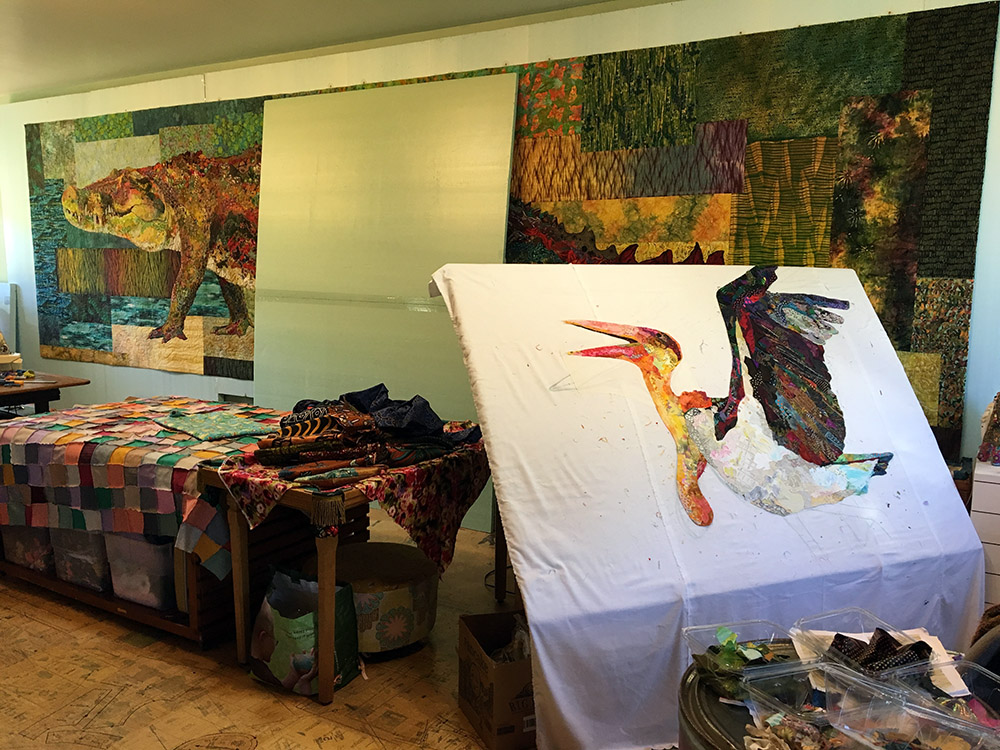
Hi Susan–enjoyed your presentation on Thursday! It was great to see you “live” and it was instructive to watch your fish/hedgehog demo. Great to see the fish again today–your timelapse videos capture your artistry and creativity in such a visual manner. Thank you for providing an artful interlude to my stay-at-home day! Be well, friend–Juliet
Amazing, you are truly gifted in how you audition, trim, layer, alter, and otherwise work with color. Nothing short of wonder on my end. I have tried to implement your technique but fall short. Keep up the great work on your blog; revisiting is wonderful because no one can do this just after one exposure!
This particular post has the best detailed pictures and “how to” or maybe i say that because I have been studying your book and joining all the Thursday night Zoom sessions and feel like I am really understanding the whole process. I promise I will start on the spiral as soon as I finish my current project of a bed quilt for my grandniece for her 18th birthday! Thank you Susan for inspiring me to get better at collage quilts.